| INTRODUCTION | DESCRIPTION | ACCESSORIES | HISTORY |
Please Click On Any Picture for a Larger Version
Aristocratof the Victorian period of
brass and glass.This particular example is unusual, in that it comes with a comprehensive and virtually complete set of accessories, including almost all of those listed in the firm's 1875 catalogue. This would have cost its original owner the then considerable sum of 264 7s, (about $27,500 (US) in 2018). Even without the accessories, the P & L No.1 was so expensive, that only the wealthy could afford to buy one on their own.
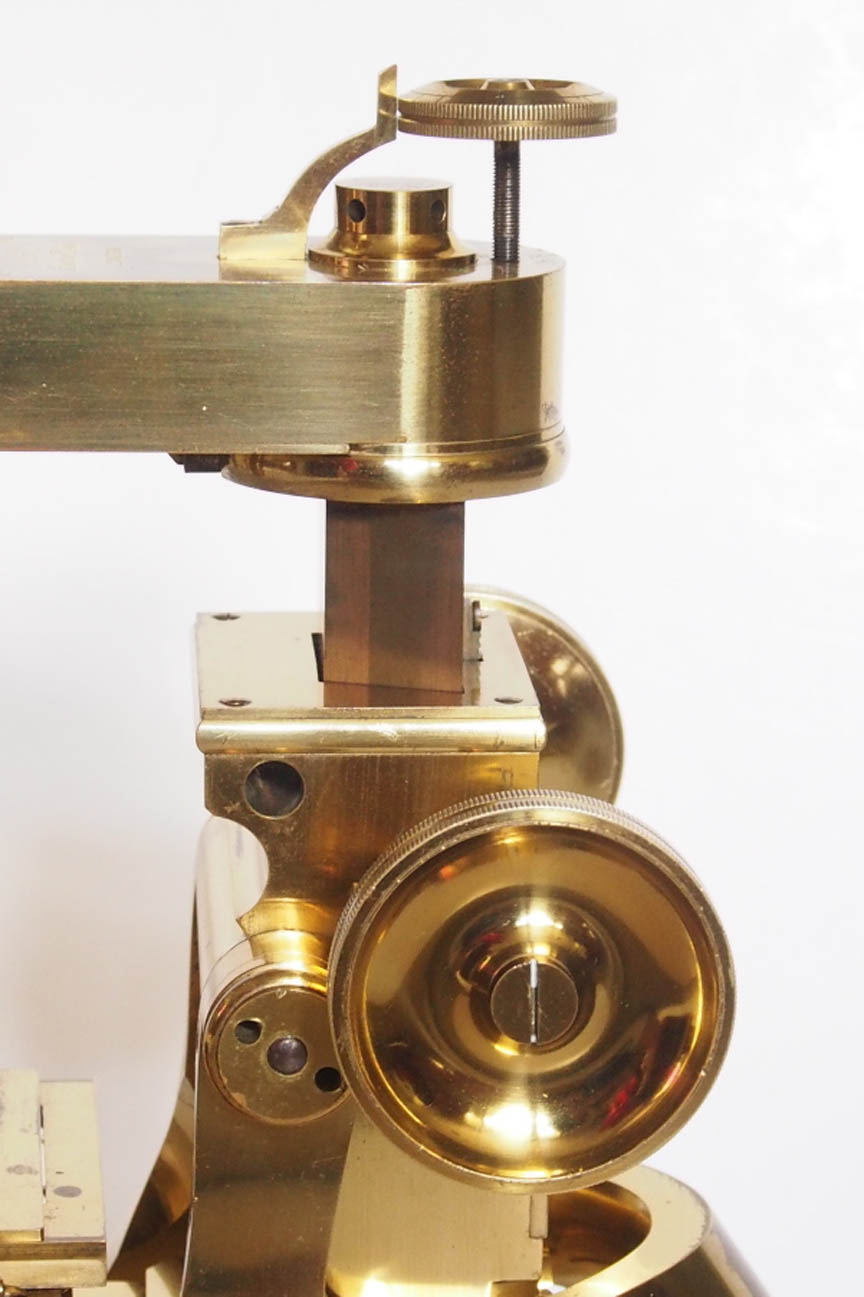
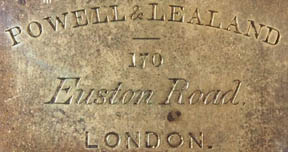
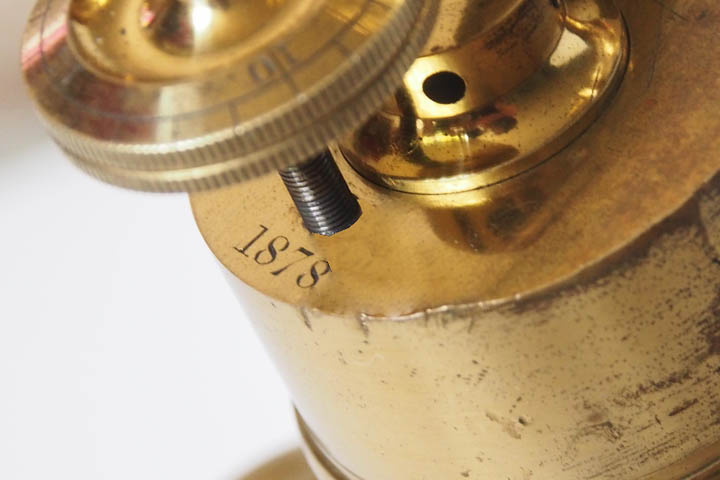 Coarse focusing is by straight cut rack and pinion, which is sprung, and can be adjusted for wear. The rack is attached to a solid bar which has a trapezoidal shape in cross section. Attached to this bar is the arm which holds the body tube. Fine focussing is by a micrometer screw acting on a long lever running through the arm, and acting on the sliding nose piece, whereby one turn of the screw represents 0.16 mm of vertical displacement. The microscope is signed on the arm: 'Powell & Lealand, 170 Euston Road, London', and dated just behind the fine adjustment screw, '1878'
Coarse focusing is by straight cut rack and pinion, which is sprung, and can be adjusted for wear. The rack is attached to a solid bar which has a trapezoidal shape in cross section. Attached to this bar is the arm which holds the body tube. Fine focussing is by a micrometer screw acting on a long lever running through the arm, and acting on the sliding nose piece, whereby one turn of the screw represents 0.16 mm of vertical displacement. The microscope is signed on the arm: 'Powell & Lealand, 170 Euston Road, London', and dated just behind the fine adjustment screw, '1878'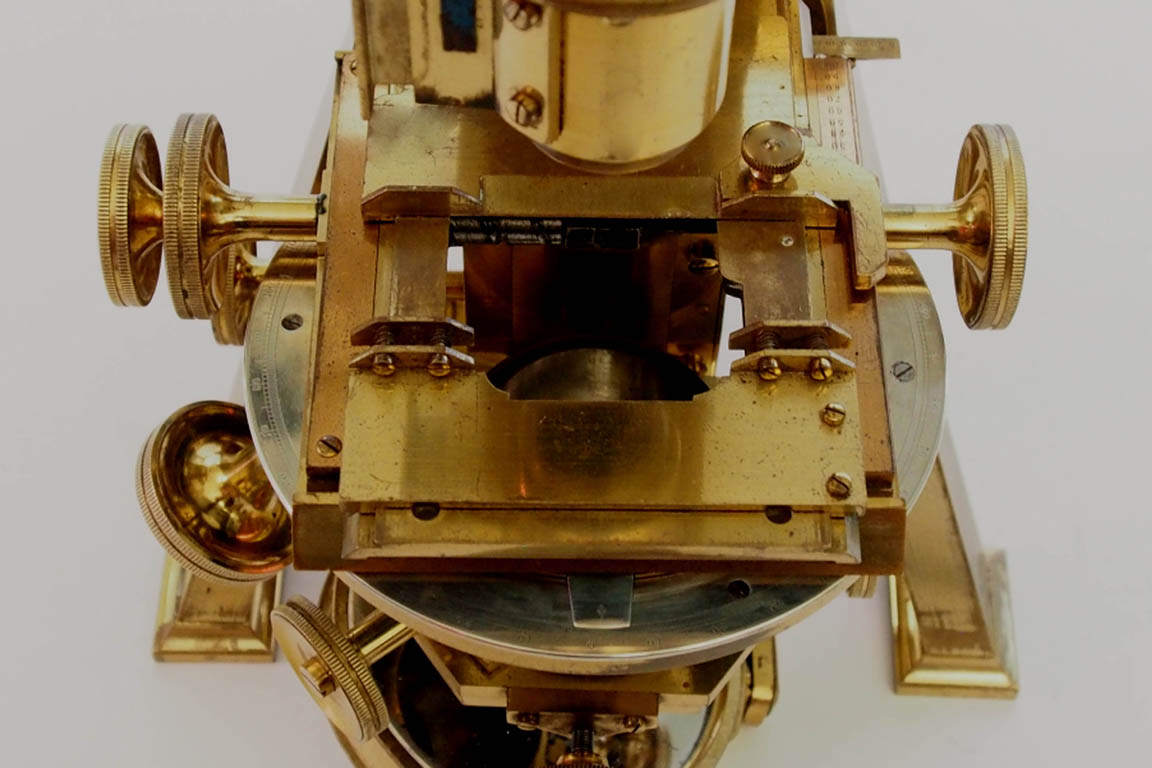
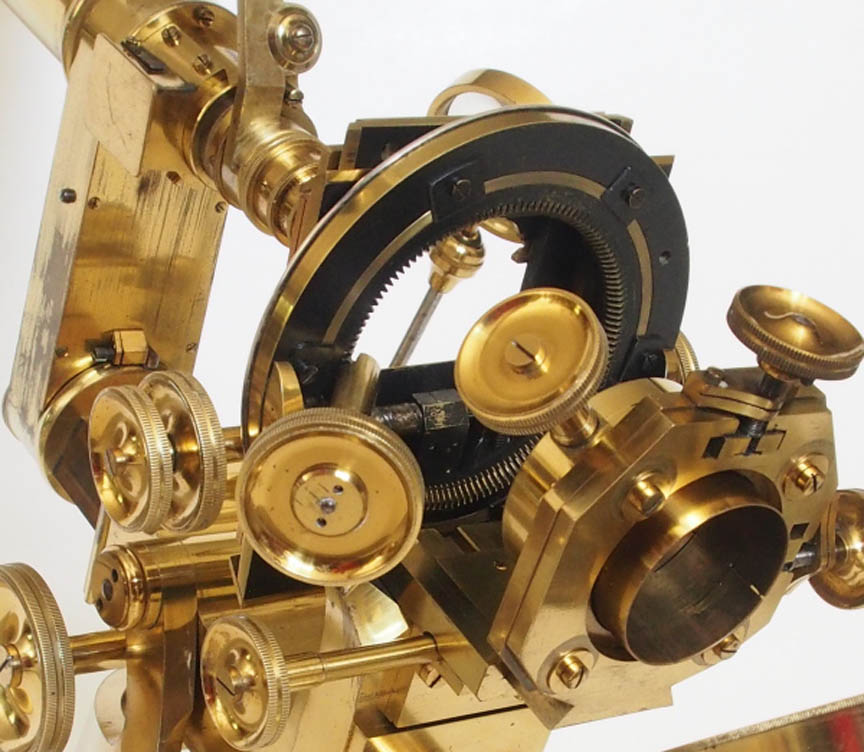 The beautifully finished Turrell stage is operated through concentric knurled knobs, allowing for a movement of 1 inch across the X and Y axes, which can be tracked on specimen-finder scales graduated 0-100. The stage can be rotated through a full circle, graduated on a silvered scale 0 180 0 by 0.5 deg. The rotating motion is operated through a conical rack and pinion movement with a diagonally placed knurled knob.
The beautifully finished Turrell stage is operated through concentric knurled knobs, allowing for a movement of 1 inch across the X and Y axes, which can be tracked on specimen-finder scales graduated 0-100. The stage can be rotated through a full circle, graduated on a silvered scale 0 180 0 by 0.5 deg. The rotating motion is operated through a conical rack and pinion movement with a diagonally placed knurled knob.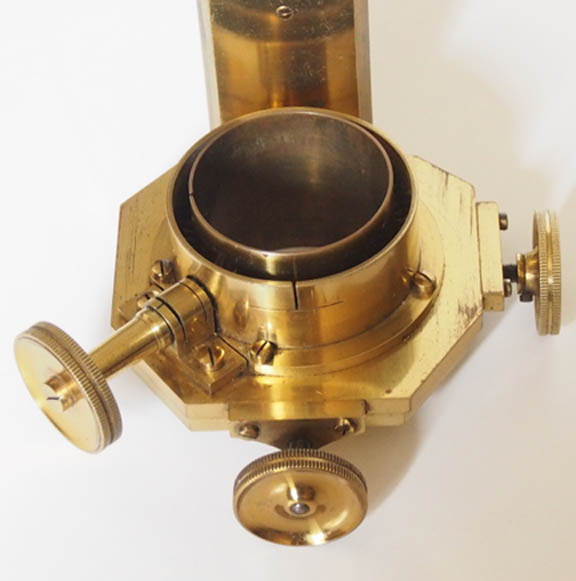 The substage mount(left), is focussed by rack and pinion, is centered by a pair of screws set at right angles (range about 3 mm for X and Y axes), and features full circular movement, activated by a diagonally placed knurled knob. We should note there is no substage fine focus, as this feature, to facilitate precise focusing of the condenser at high power, was not added until 1882.
The substage mount(left), is focussed by rack and pinion, is centered by a pair of screws set at right angles (range about 3 mm for X and Y axes), and features full circular movement, activated by a diagonally placed knurled knob. We should note there is no substage fine focus, as this feature, to facilitate precise focusing of the condenser at high power, was not added until 1882. 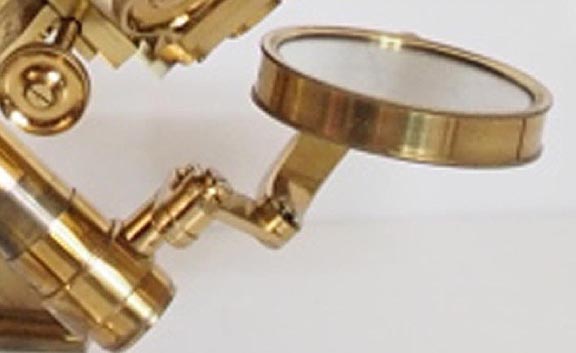 The large plano concave mirror(right)is 3 inches in diameter, and is on an articulated arm attached to a collar running on the tail piece of the lower limb.
The large plano concave mirror(right)is 3 inches in diameter, and is on an articulated arm attached to a collar running on the tail piece of the lower limb.
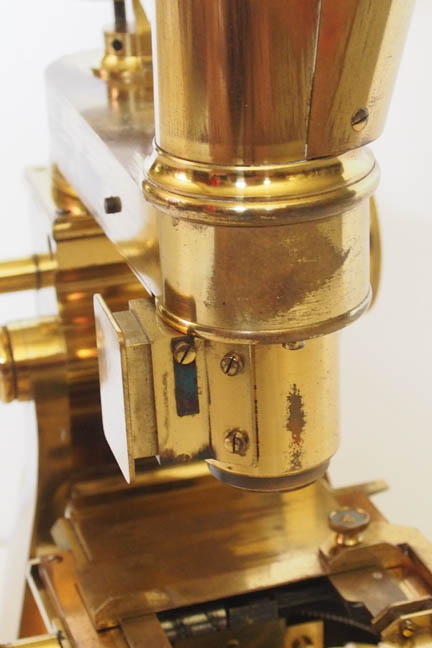
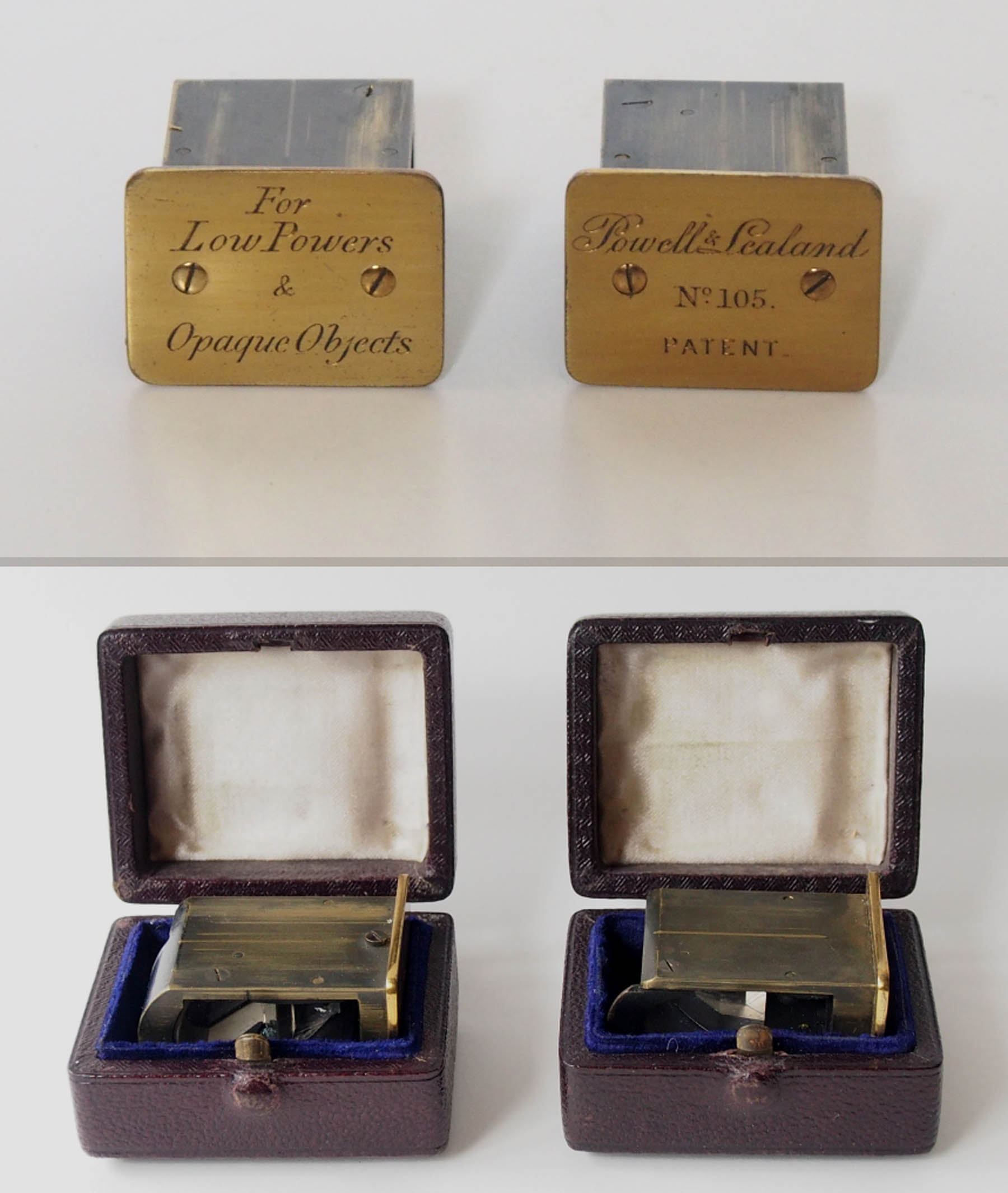 The binocular body tube can be fitted with one of two different prisms, each contained in its own maroon leather case, lined with blue velvet, and white silk inside the lid. The first is engraved
The binocular body tube can be fitted with one of two different prisms, each contained in its own maroon leather case, lined with blue velvet, and white silk inside the lid. The first is engraved For Low Powers and Opaque objects. This is of the classic Wenham design, producing stereoscopic vision through a single objective with focal lengths down to inch, and an angle of aperture not much more than 50 degrees. The other is engraved
Powell & Lealand No 105 patent. This features a prism arrangement of their own design, intended to produce binocular non-stereoscopic vision at high powers of magnification. Inevitably with this arrangement, the image seen with the left eye is much fainter than the right.
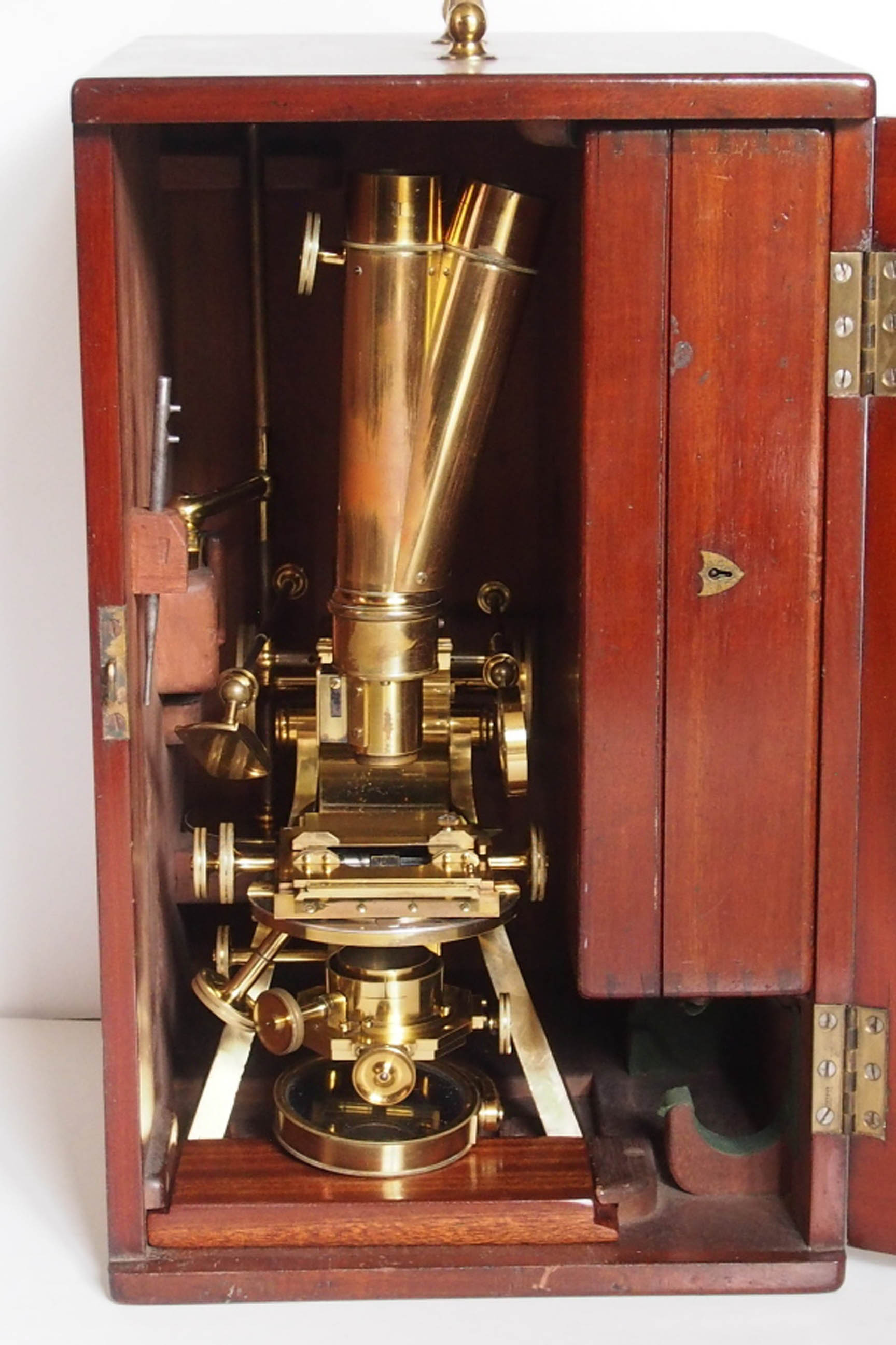 The No 1 comes in its original nicely finished original mahogany case measuring 280 (w) x 328 (D) x 460 mm (H), in which slides a mahogany accessory case in a vertical position on the right hand side. This measures 300 x 324 x 85 mm. The uprights in the case are lined with a mid-green baize. The case also contains a bulls-eye condenser on stand, and a tommy bar for adjustments. There is storage facility for a monocular tube, which unfortunately is no longer present. The whole ensemble weighs some 20 Kg. The door is of simple solid unframed construction.
The No 1 comes in its original nicely finished original mahogany case measuring 280 (w) x 328 (D) x 460 mm (H), in which slides a mahogany accessory case in a vertical position on the right hand side. This measures 300 x 324 x 85 mm. The uprights in the case are lined with a mid-green baize. The case also contains a bulls-eye condenser on stand, and a tommy bar for adjustments. There is storage facility for a monocular tube, which unfortunately is no longer present. The whole ensemble weighs some 20 Kg. The door is of simple solid unframed construction.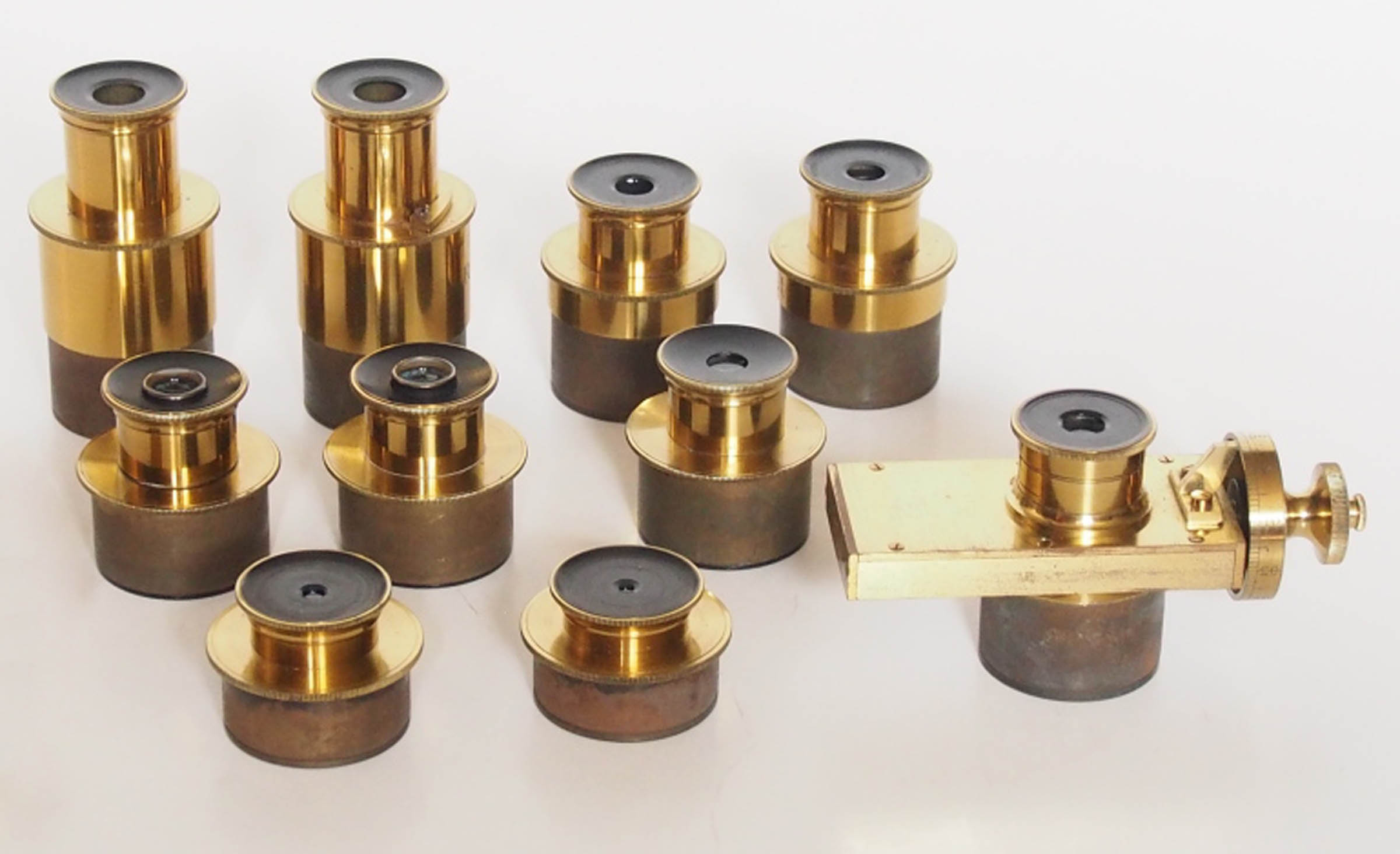 The eyepieces are of a large diameter (1.43 inch = 36.4 mm), the same size as the push-in fit for the substage mount, so that any eyepiece can be used as a condenser. The achromatic Kellner eyepiece was recommended for this purpose in particular. Eyepieces include 3 sets of twin eyepieces, No 1 (5x), No 2 (7.5x), and Kellner (Orthoscopic 10x). One of the No 1, and 2 eyepieces each is marked R , whilst the No 1 R is fitted with a moveable pointer. In addition, 3 single eyepieces are included: No 3 (10x), No 4 (20x), and No 5 (30x), all on the Huygens principle. A Ramsden eyepiece micrometer is also included, made of heavy lacquered brass. It has a wheel, which is graduated 0-100 parts, and is activated by a knurled knob. It seems to be in as new condition, with both wires in place.
The eyepieces are of a large diameter (1.43 inch = 36.4 mm), the same size as the push-in fit for the substage mount, so that any eyepiece can be used as a condenser. The achromatic Kellner eyepiece was recommended for this purpose in particular. Eyepieces include 3 sets of twin eyepieces, No 1 (5x), No 2 (7.5x), and Kellner (Orthoscopic 10x). One of the No 1, and 2 eyepieces each is marked R , whilst the No 1 R is fitted with a moveable pointer. In addition, 3 single eyepieces are included: No 3 (10x), No 4 (20x), and No 5 (30x), all on the Huygens principle. A Ramsden eyepiece micrometer is also included, made of heavy lacquered brass. It has a wheel, which is graduated 0-100 parts, and is activated by a knurled knob. It seems to be in as new condition, with both wires in place.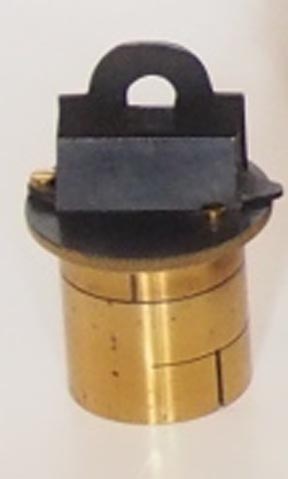 CAMERA LUCIDA:
CAMERA LUCIDA: 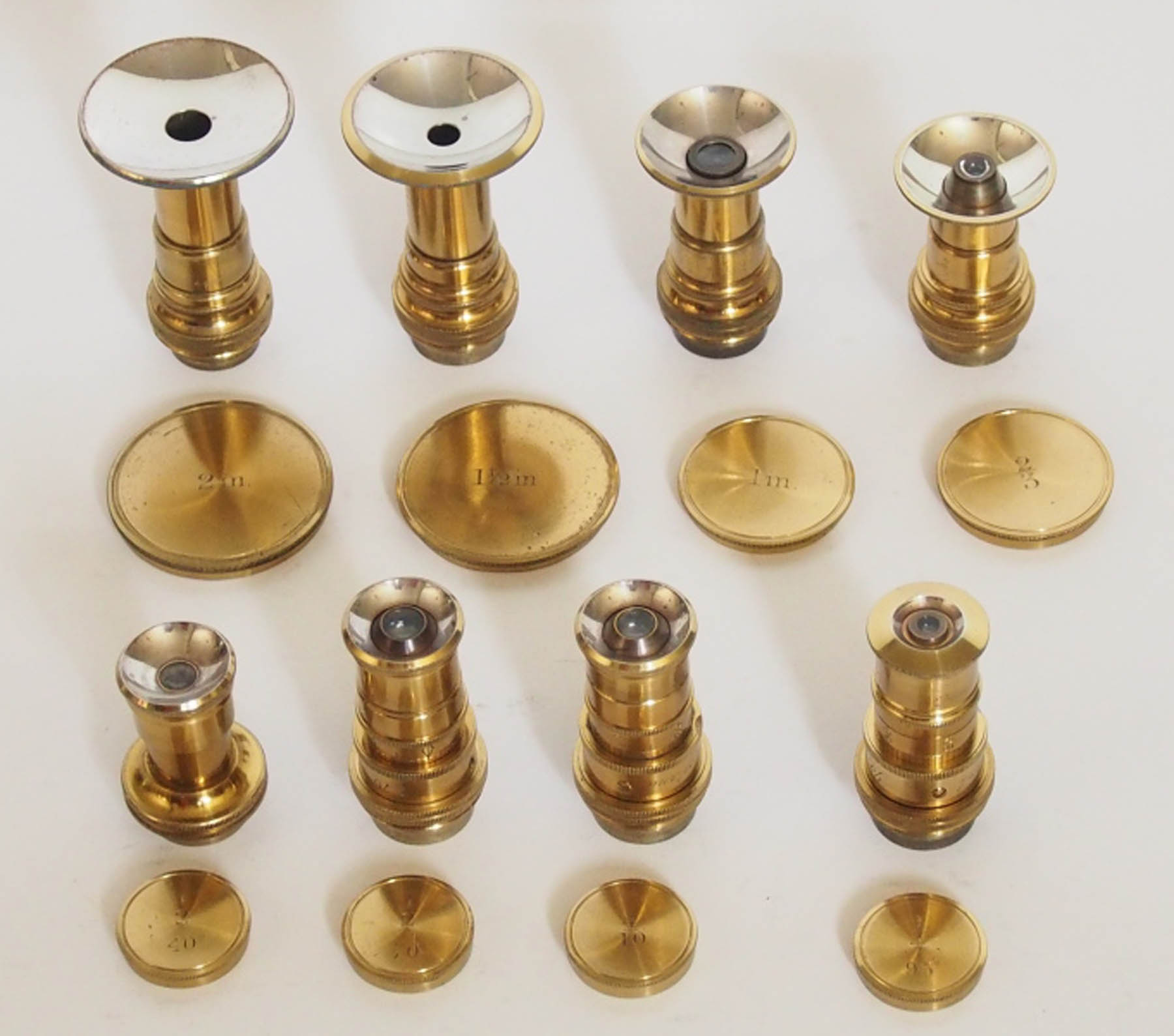 Lieberkuhns, fitting over the objectives,are included to fit objectives ranging from 2 inch to 1/4 inch focal length. They reflect and concentrate light coming from below an opaque subject onto to the subject, as when using the Dark Wells, or when viewing small opaque objects.
Lieberkuhns, fitting over the objectives,are included to fit objectives ranging from 2 inch to 1/4 inch focal length. They reflect and concentrate light coming from below an opaque subject onto to the subject, as when using the Dark Wells, or when viewing small opaque objects.
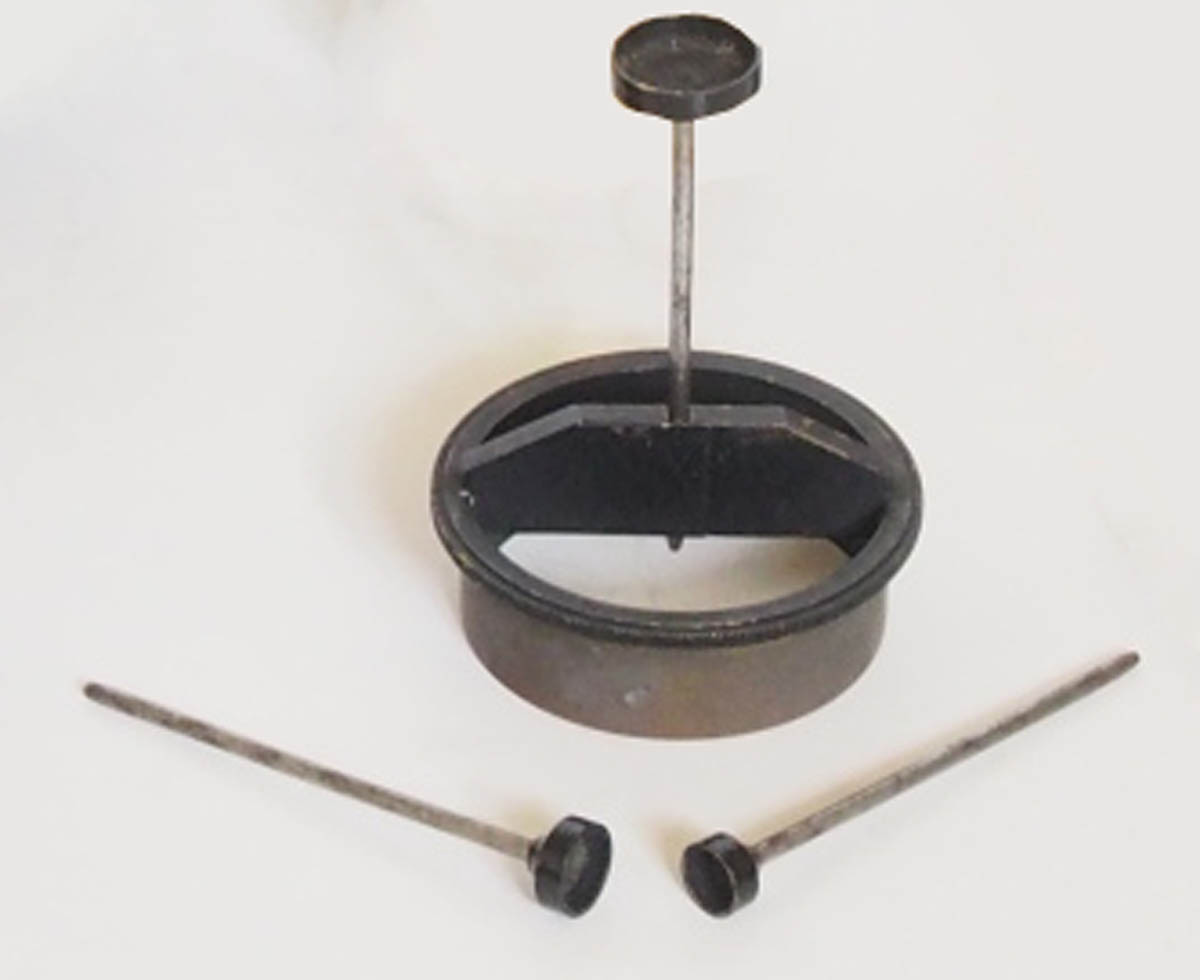 Fitting in the substage sleeve is a holder for dark wells, of which 3 of the original 4 are still present. They serve to provide a dark surrounding for an opaque subject illuminated from above. This reduces glare and reflection near the subject, making it easier to see details.
Fitting in the substage sleeve is a holder for dark wells, of which 3 of the original 4 are still present. They serve to provide a dark surrounding for an opaque subject illuminated from above. This reduces glare and reflection near the subject, making it easier to see details.
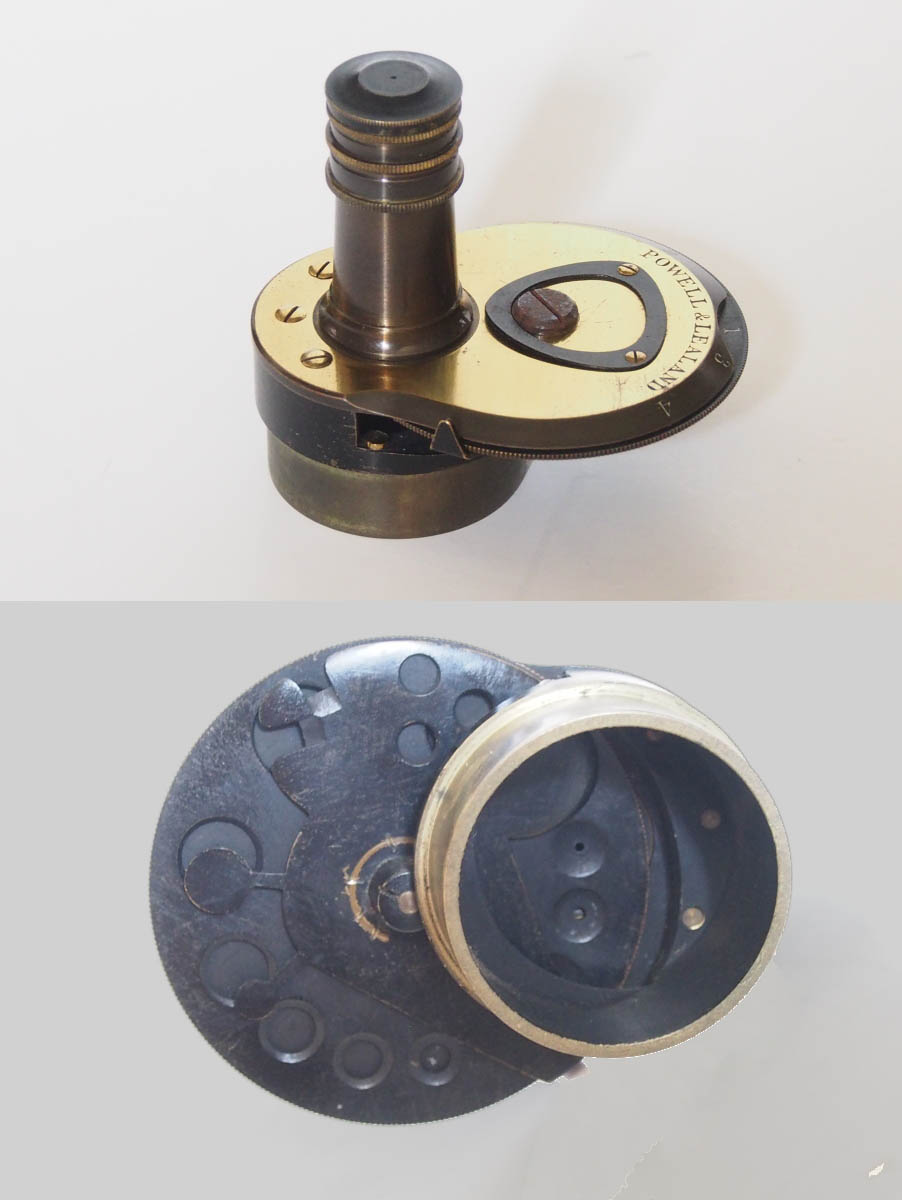
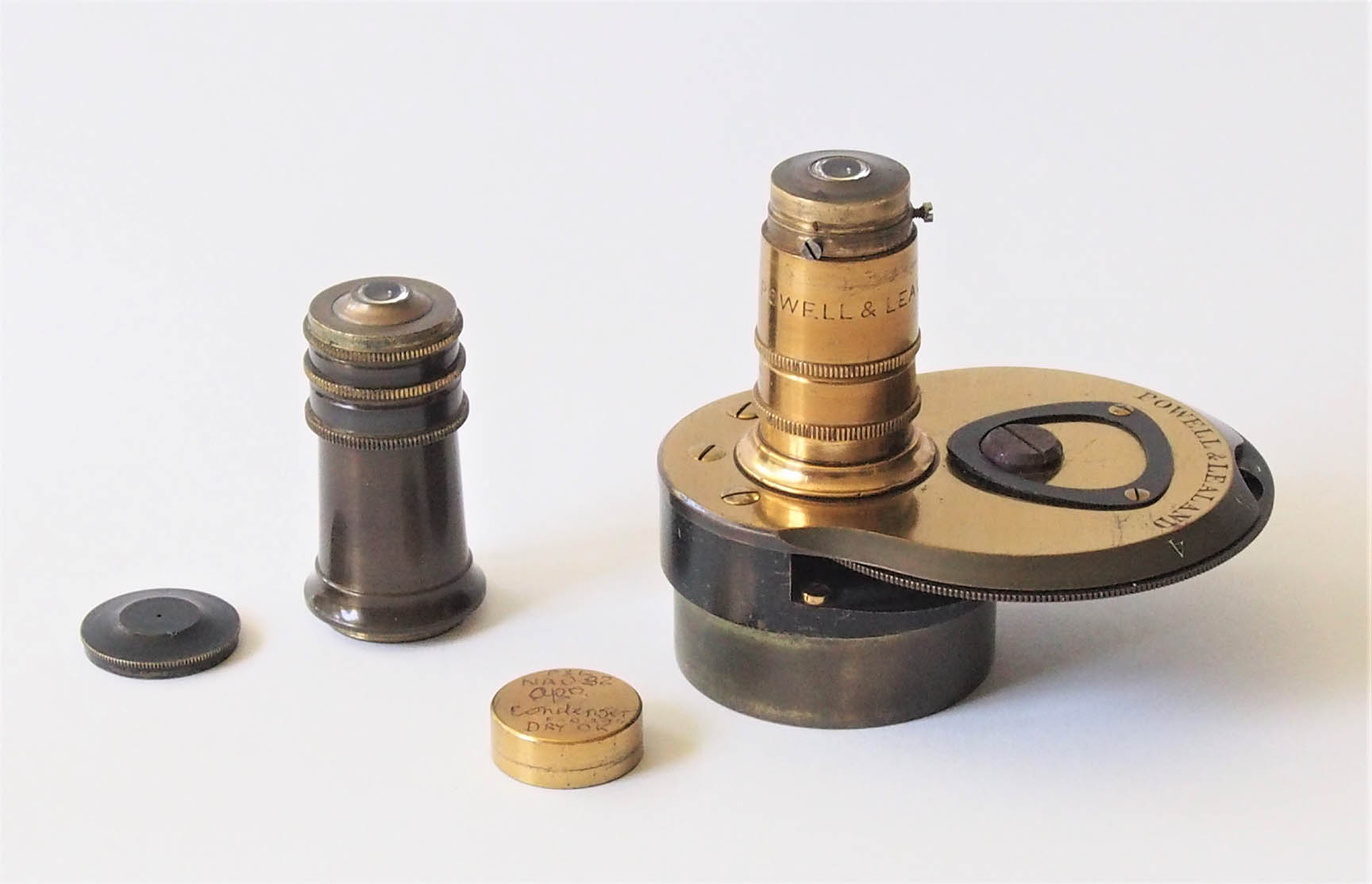 With the introduction of apochromatic objectives, Powell & Lealand introduced an apochromatic condenser in 1891. This was also designed to be used dry, and had an advertised focal length of 1/4 inch, and N.A. of 0.95. This came as the optical part only, and screwed onto the High Power Achromatic condenser housing instead of the achromatic element.This design was later modified at the suggestion of E.M. Nelson, to include an adjustment for slide thickness operated by a lever. The example shown here was at one stage repaired, and the top element has been fitted with 3 tiny centering screws. The cap is engraved:
With the introduction of apochromatic objectives, Powell & Lealand introduced an apochromatic condenser in 1891. This was also designed to be used dry, and had an advertised focal length of 1/4 inch, and N.A. of 0.95. This came as the optical part only, and screwed onto the High Power Achromatic condenser housing instead of the achromatic element.This design was later modified at the suggestion of E.M. Nelson, to include an adjustment for slide thickness operated by a lever. The example shown here was at one stage repaired, and the top element has been fitted with 3 tiny centering screws. The cap is engraved: P & L N.A. 0.92 Apo condenser F=0.29" Dry OKin the unmistakeable handwriting and annotation of the late Horace Dall (1901-1986), optical genius, of Luton, England, by many considered to have been the last person who was capable of repairing defective Powell & Lealand objectives.
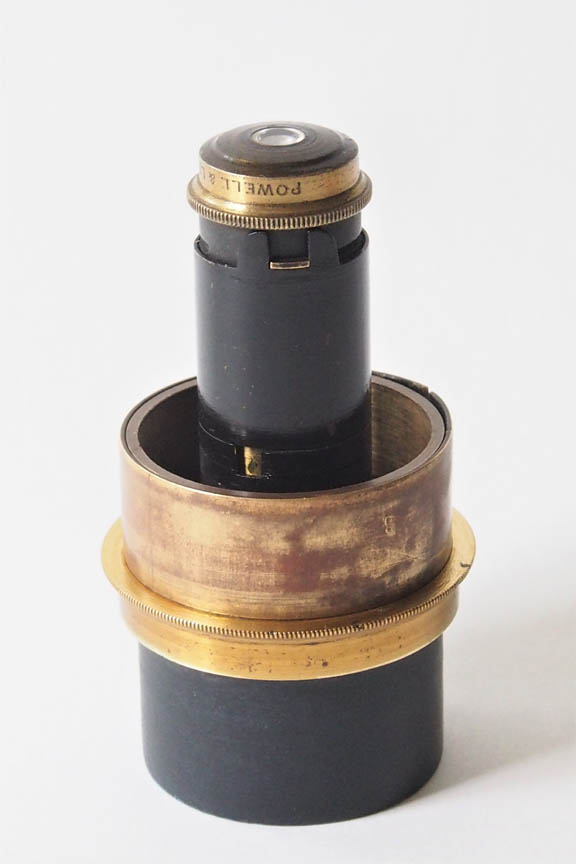
truncated, i.e. all optical parts are combined in a single brass cell, which screws into the top of the sleeve. In their 1895 catalogue, Powell & Lealand advertise this version as having an N.A. of 1.40, the cost being 1 Pound 10 Shillings extra. This condenser was also made for other microscope makers, such as the firm of Watson, which at that stage did not as yet make their own oil immersion condensers. This particular example was made to be fitted into an under stage sleeve. The present owner has added an adaptor which allows it to be used in the original P & L substage. The engraved illustration shows the condenser in its usual guise.
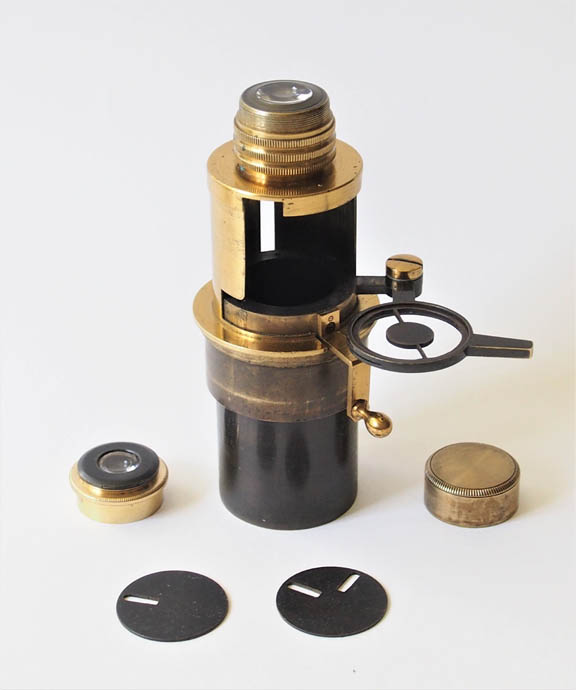
elevator, taking the stops up to the required position, so that they could be changed while the condenser remained focused on the slide. On this design, an achromatic version (N.A. 1.30)was constructed in 1886, and one on the apochromatic principle (N.A. 1.40) in 1891. Apart from being listed in Powell & Lealand's own catalogues, this condenser was also advertised by W. Watson & Sons in 1902:
Powell & Lealand's Apochromatic oil immersion condenser, 1.4 N.A. mounted in P & L's special carrier, with stops, complete GBP 12 0 0 .

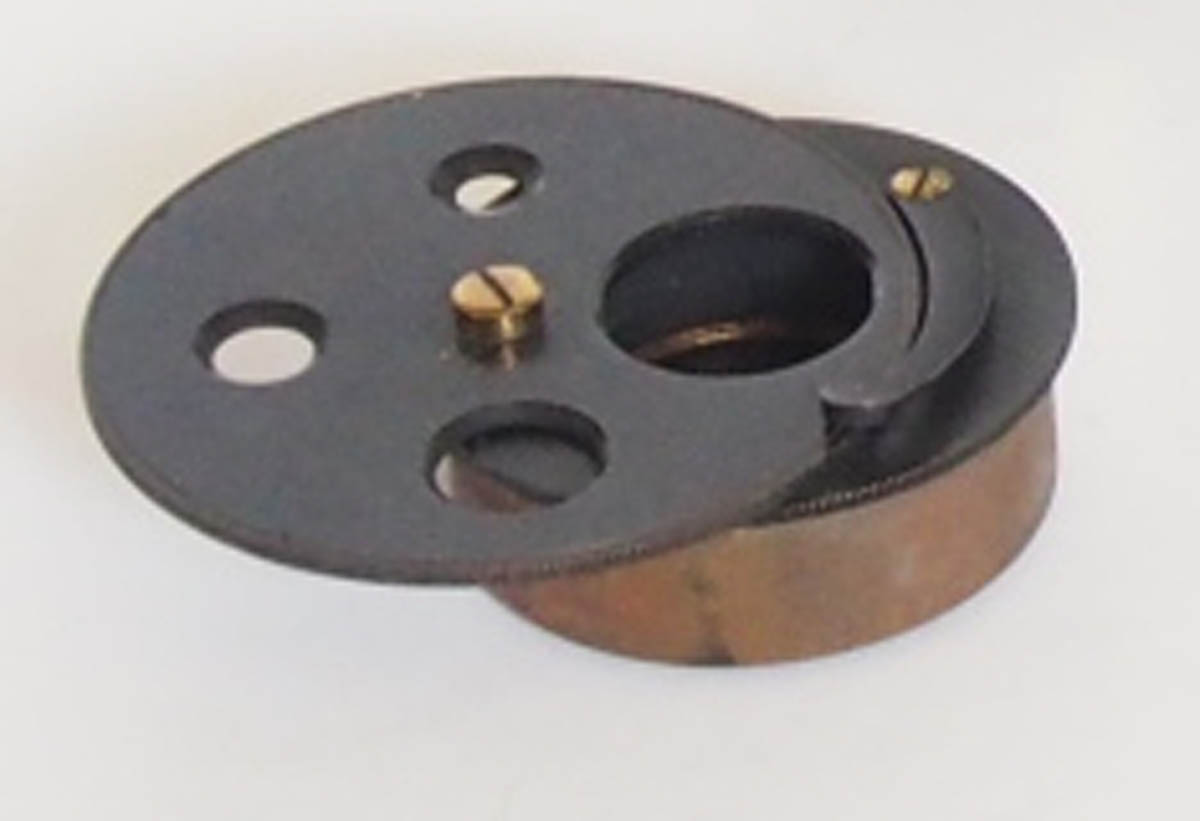 There is a diaphragm with 4 rotating aperture stops and a blue filter, which inserts into the substage sleeve. In the catalogue this is referred to as
There is a diaphragm with 4 rotating aperture stops and a blue filter, which inserts into the substage sleeve. In the catalogue this is referred to as Rainey s light modifier.
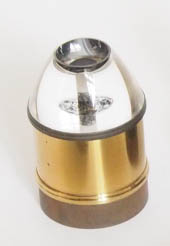
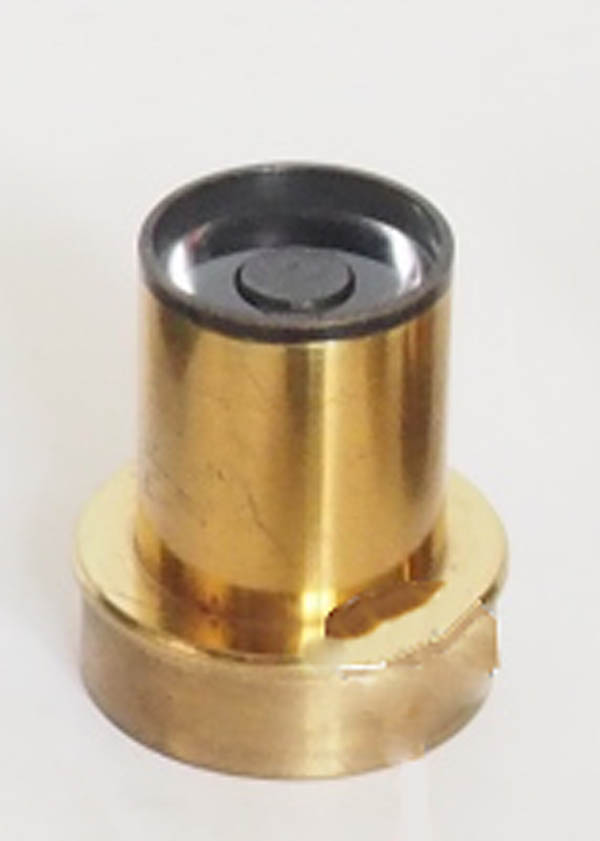 For dark ground use, there is a Wenham-Shadbolt parabolic illuminator with adjustable center stop(left). There is also spot condenser for lower power dark ground work(right).
For dark ground use, there is a Wenham-Shadbolt parabolic illuminator with adjustable center stop(left). There is also spot condenser for lower power dark ground work(right).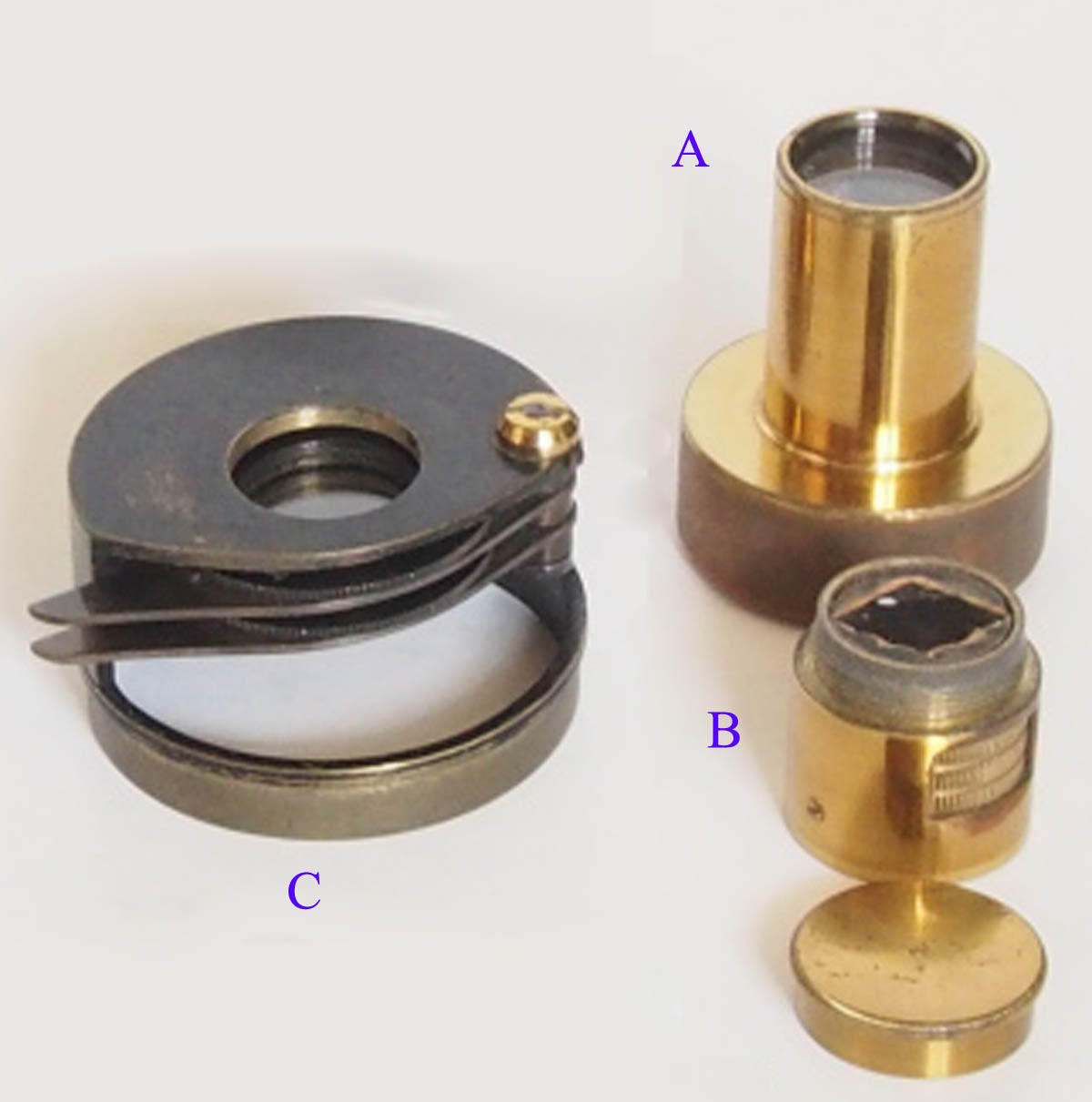 POLARIZED LIGHT ACCESSORIES:
POLARIZED LIGHT ACCESSORIES: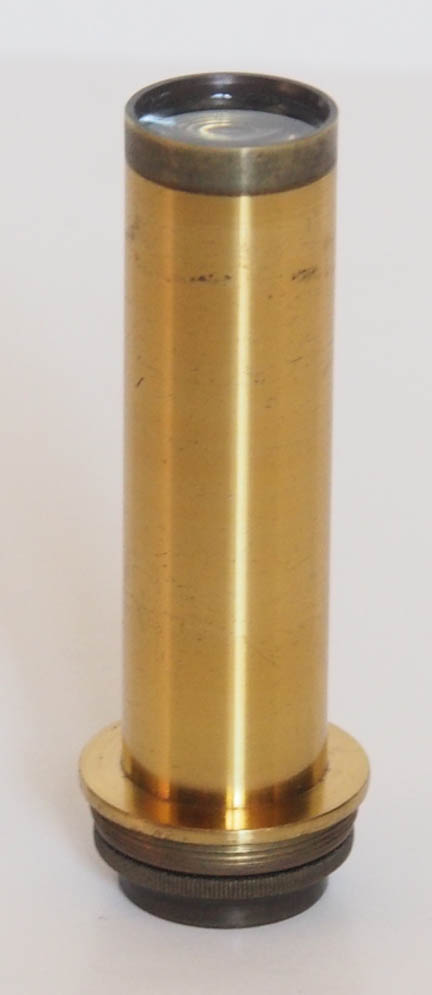 ERECTING LENS:
ERECTING LENS: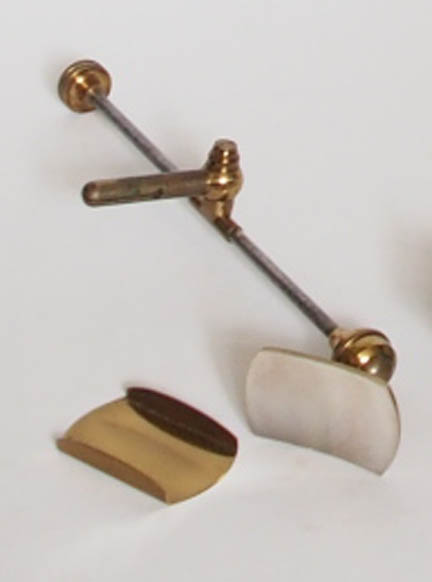 SILVERED SIDE REFLECTOR:
SILVERED SIDE REFLECTOR: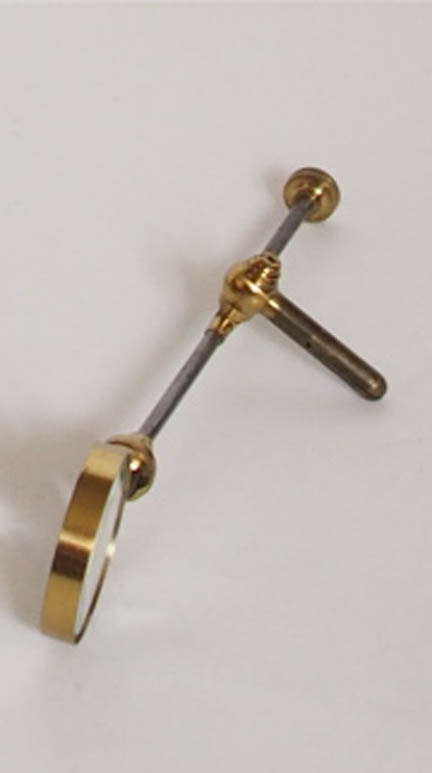 STAGE BULLSEYE CONDENSER:
STAGE BULLSEYE CONDENSER: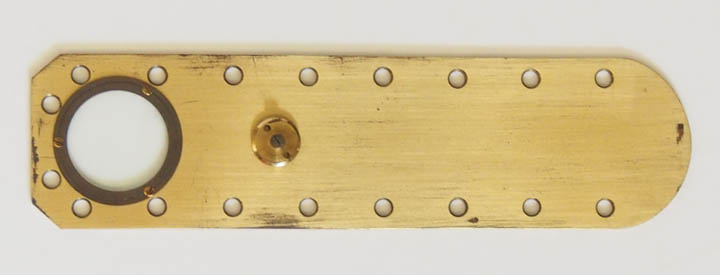 FROG PLATE:
FROG PLATE: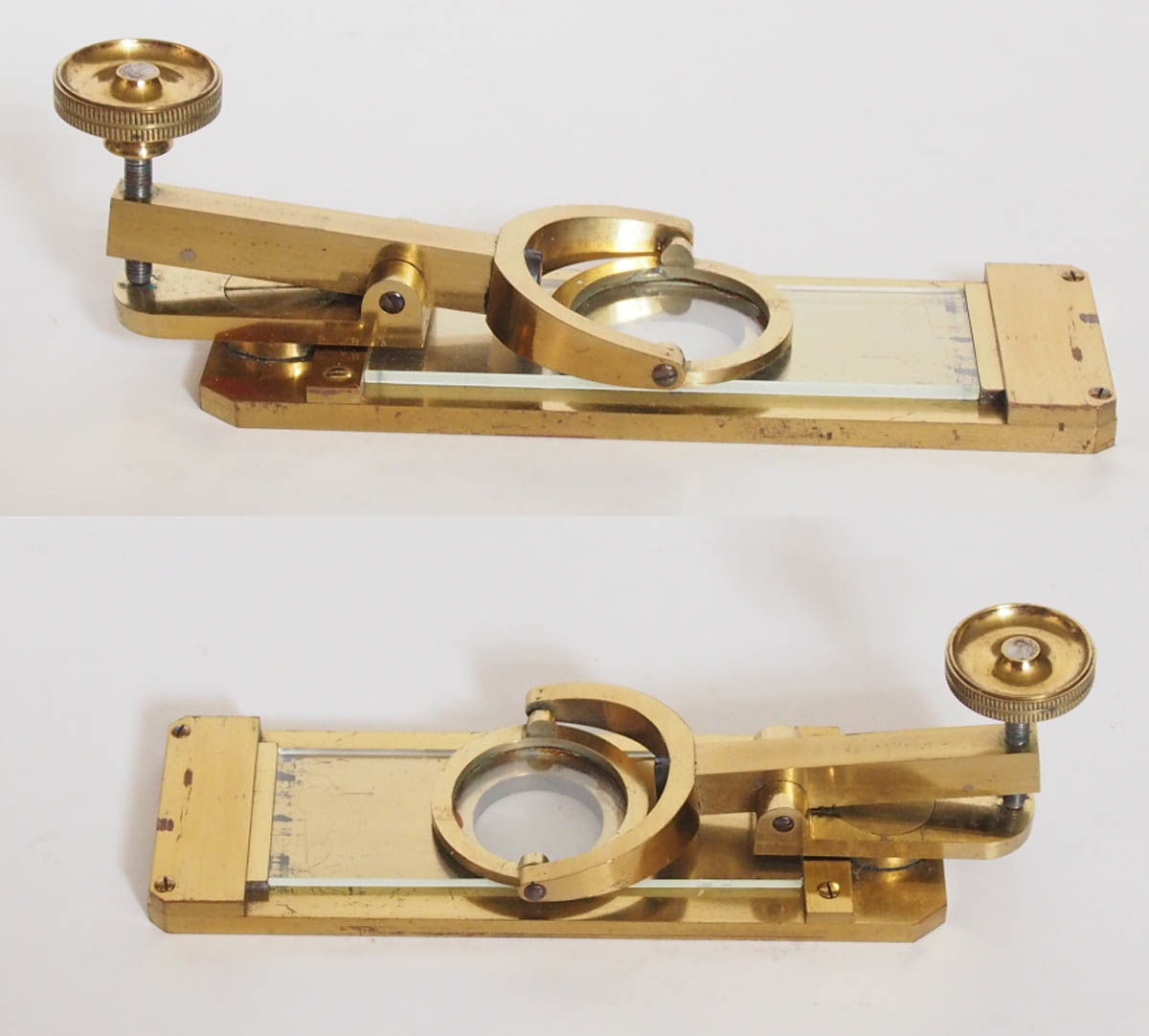 COMPRESSORIUM:
COMPRESSORIUM: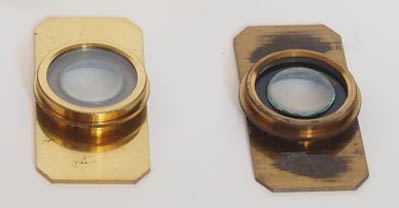 LIVEBOXES:
LIVEBOXES: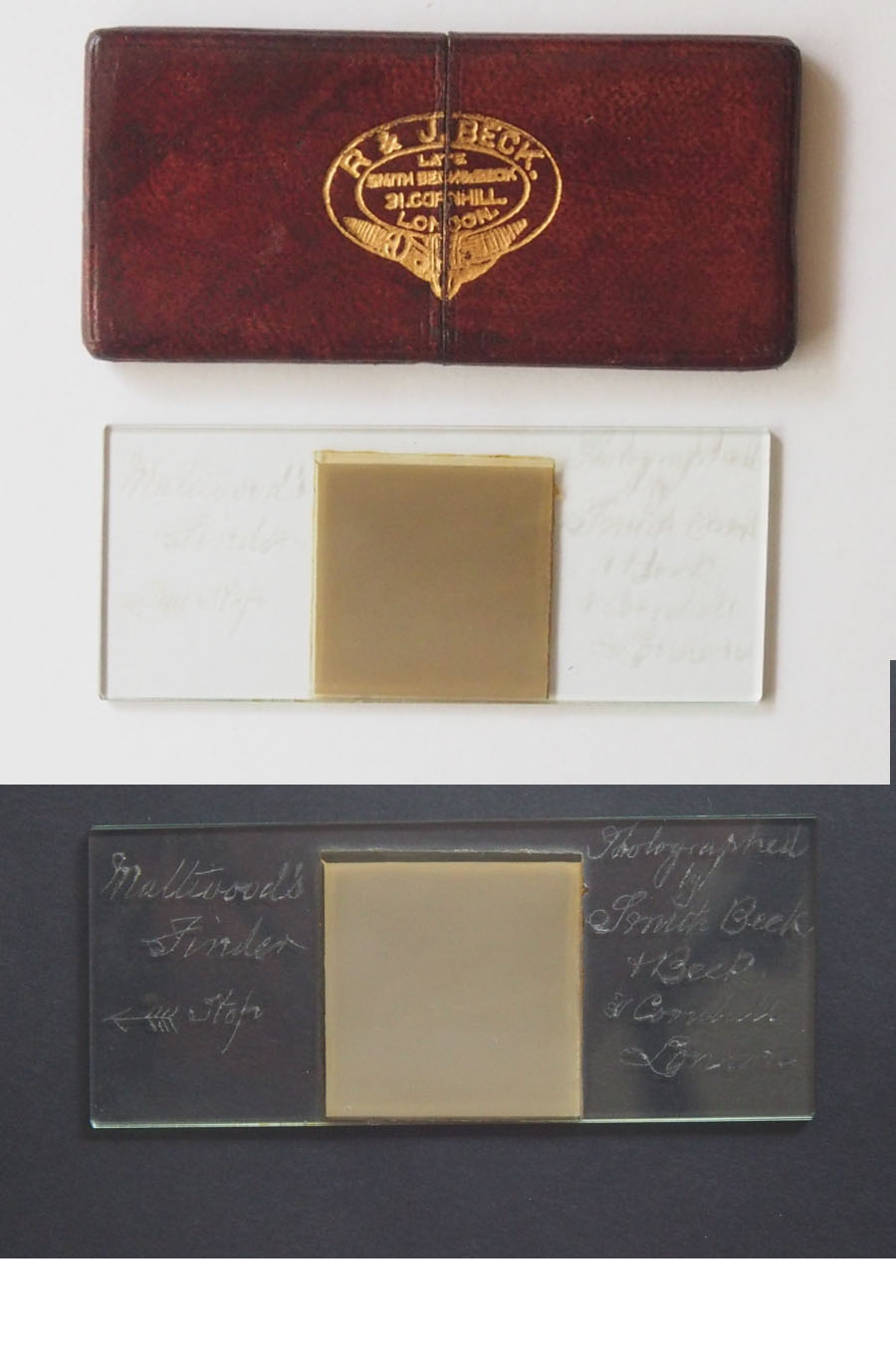
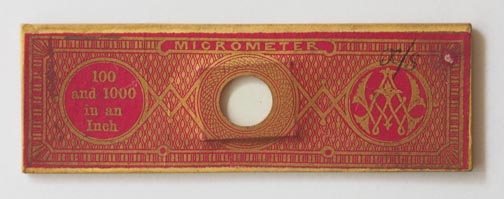 SPECIAL SLIDES:
SPECIAL SLIDES: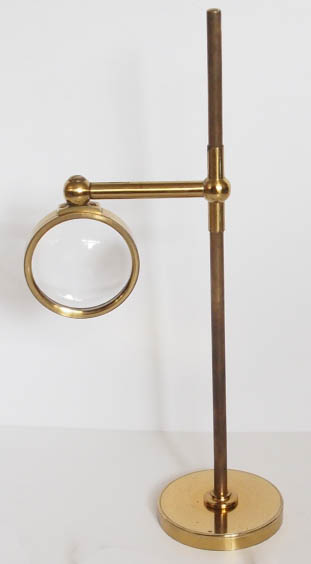 BULLSEYE BENCH CONDENSER:
BULLSEYE BENCH CONDENSER: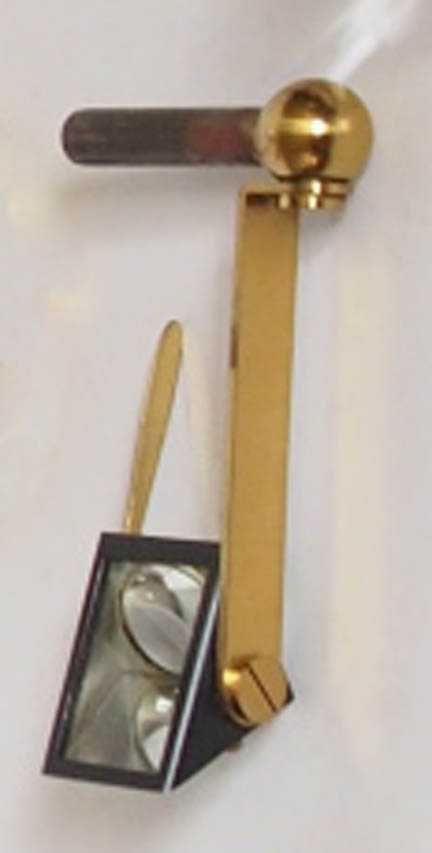
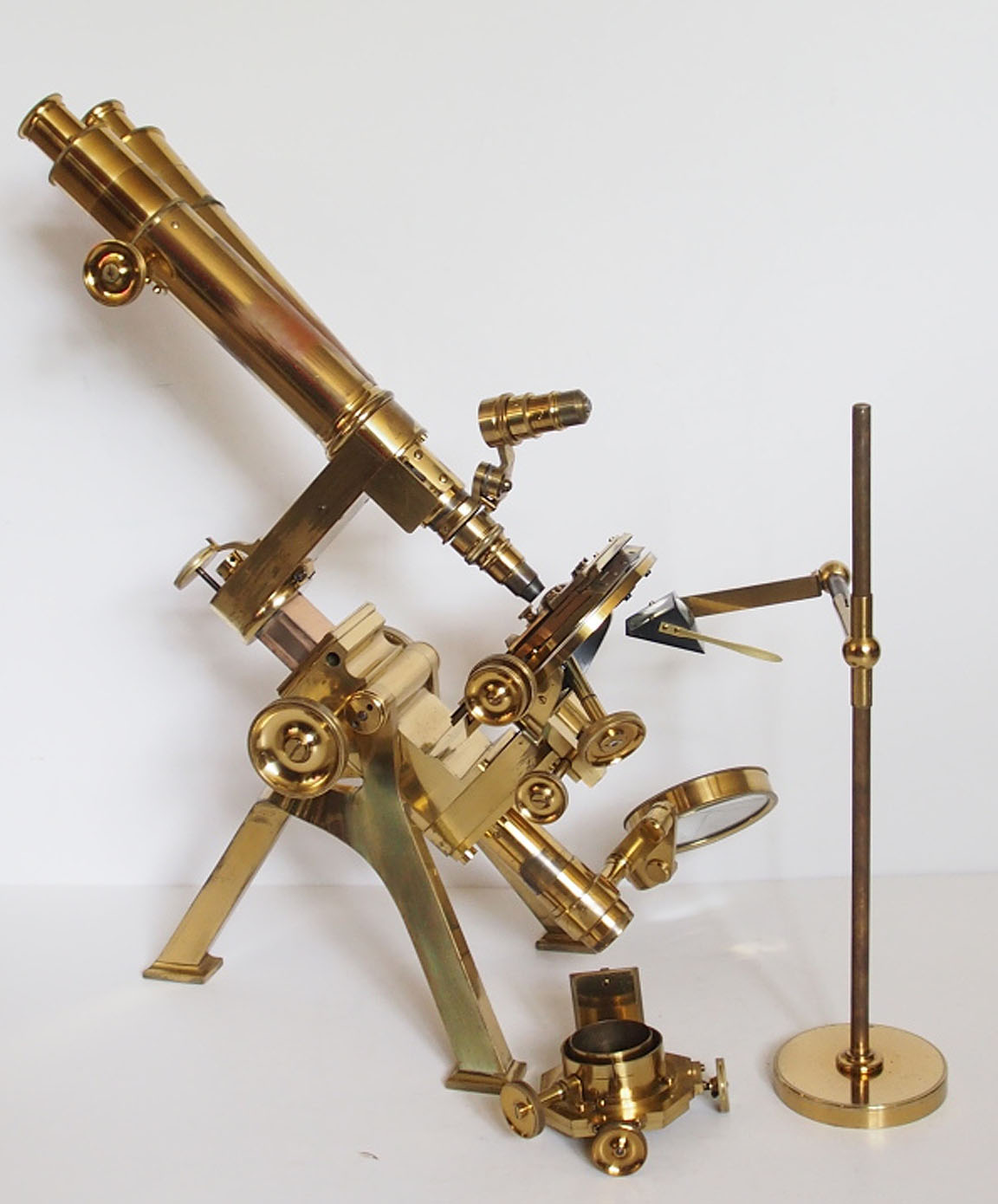 ACHROMATIC PRISM:
ACHROMATIC PRISM: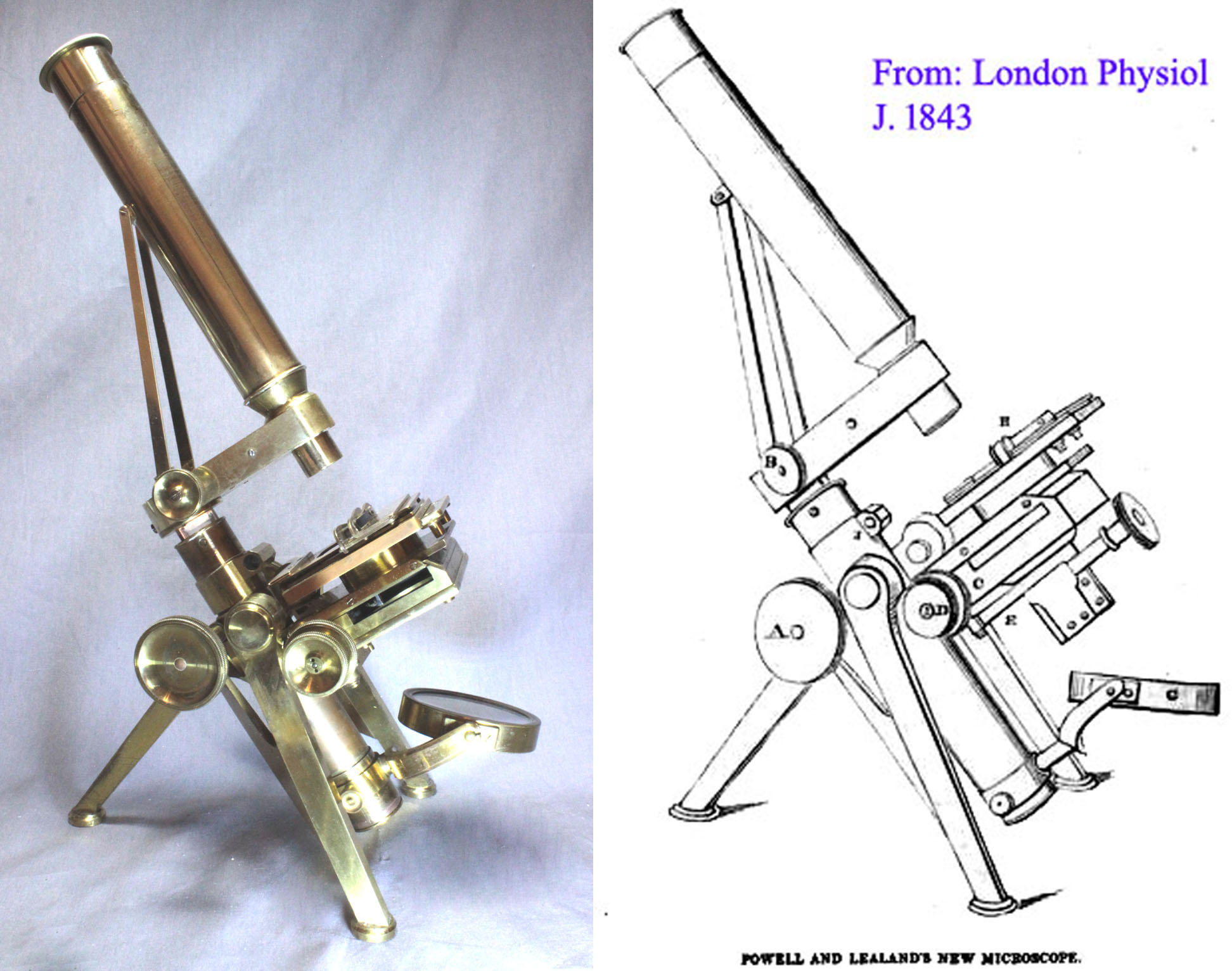 Although larger model microscope stands had been produced by Hugh Powell, notably the massive stand commissioned by the Royal Microscopical Society in 1840, what is now known as the No 1 Model was a direct development of Powell & Lealand s new tripod-based stand of 1843, seen to the left, click on the image for larger and additional images. As shown here, this stand was first described in that year s November issue of The London Physiological Journal as Powell & Lealand s new microscope . This is supported by a lighter version of the tripod, which carries the body on trunnions, and a transverse arm, which contains the long lever, which moves the nose piece fine-focus adjustment. Initially, the fine-focus screw, which operated a cone, was placed on the right side of the arm. In 1847 this was moved to the familiar vertical position on the top of the arm, immediately behind its pivot. At this stage, the microscope tube was also supported by a set of diagonal stabilizing struts extending from the back of the arm to the upper third of the tube. Sometime during the early 1860's these were abandoned.
Although larger model microscope stands had been produced by Hugh Powell, notably the massive stand commissioned by the Royal Microscopical Society in 1840, what is now known as the No 1 Model was a direct development of Powell & Lealand s new tripod-based stand of 1843, seen to the left, click on the image for larger and additional images. As shown here, this stand was first described in that year s November issue of The London Physiological Journal as Powell & Lealand s new microscope . This is supported by a lighter version of the tripod, which carries the body on trunnions, and a transverse arm, which contains the long lever, which moves the nose piece fine-focus adjustment. Initially, the fine-focus screw, which operated a cone, was placed on the right side of the arm. In 1847 this was moved to the familiar vertical position on the top of the arm, immediately behind its pivot. At this stage, the microscope tube was also supported by a set of diagonal stabilizing struts extending from the back of the arm to the upper third of the tube. Sometime during the early 1860's these were abandoned. 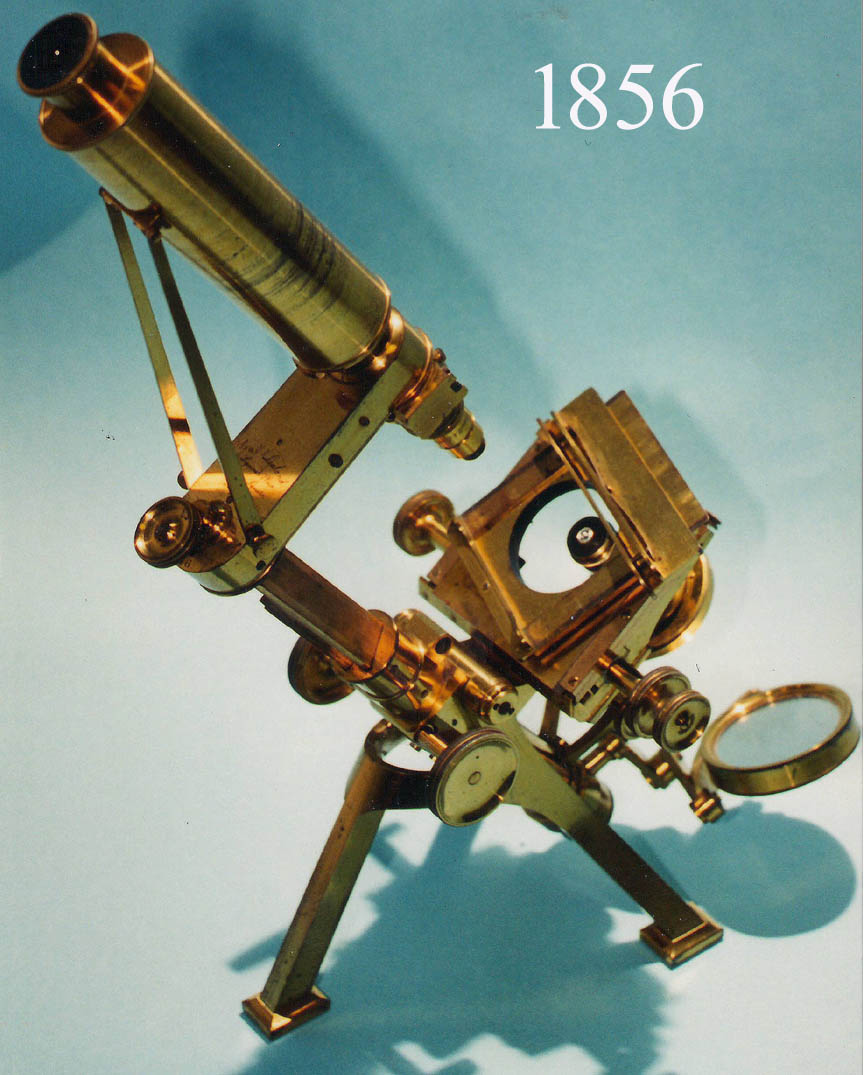 Powell & Lealand did not enter the 1851 Great Exhibition, but it is believed that during this time they worked on a larger model based on this design. Dated examples are extant from this period, with the more solid rectangular feet as in the later No 2 stand, either with or without the supporting struts. These could be regarded as the 'proto-No 1/No 2 stands', from which the later models were developed. Two examples of these, called the
Powell & Lealand did not enter the 1851 Great Exhibition, but it is believed that during this time they worked on a larger model based on this design. Dated examples are extant from this period, with the more solid rectangular feet as in the later No 2 stand, either with or without the supporting struts. These could be regarded as the 'proto-No 1/No 2 stands', from which the later models were developed. Two examples of these, called the Improved Large First Class Microscopeare found on this site, and still have struts supporting the tube. The more detailed account of the Improved Large First Class model, dated 1854, includes many additional details about it and its history. As seen in the image to the left, the Improved First Class stand of 1856, is similar to the 1843, stand other than the position of the fine focus knob, the rack and pinion substage, the design of a heftier tripod, and the rectangular and heavier tripod legs.
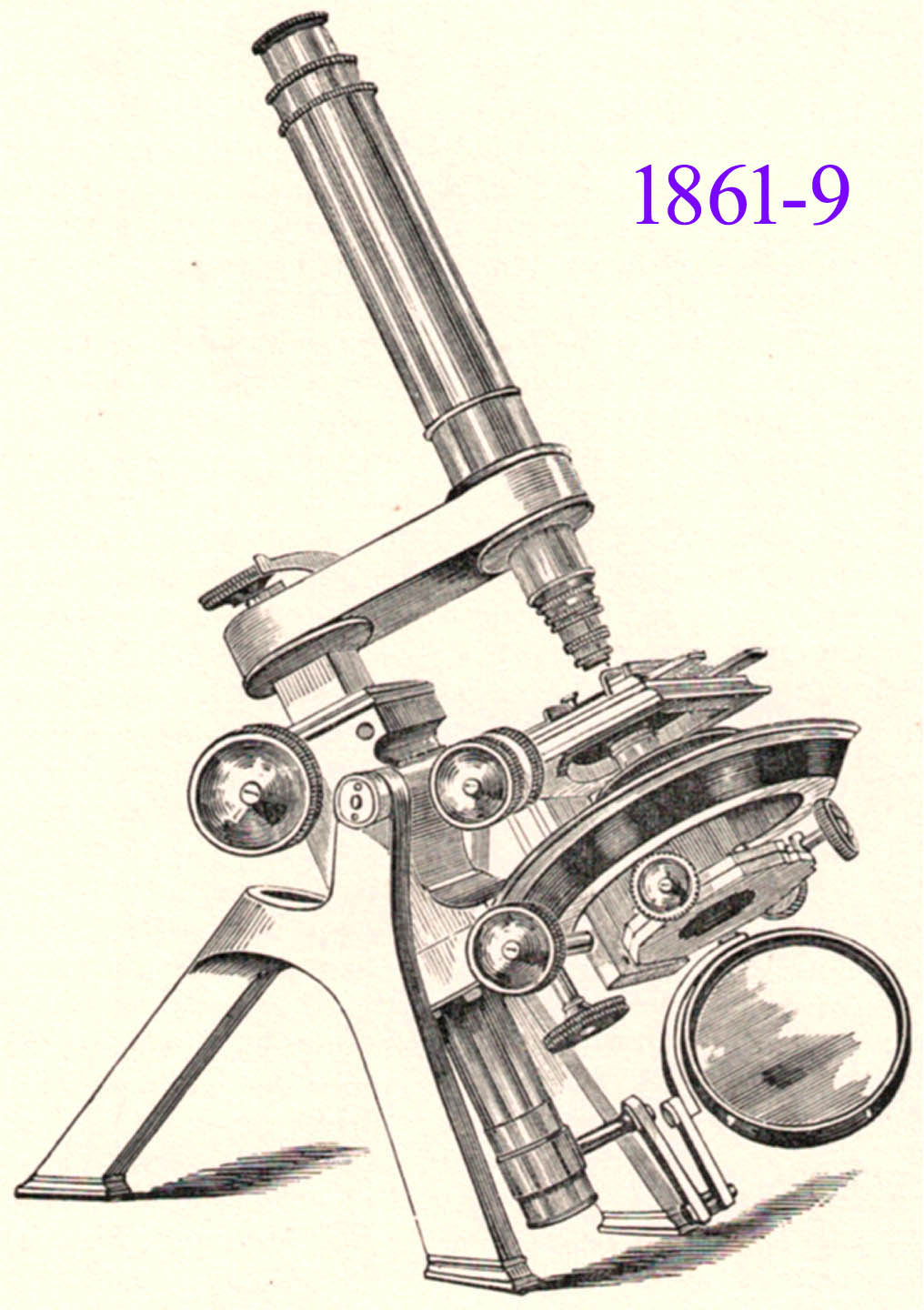 The next model(left) was worked on at odd times, and appeared in 1861. It was similar in outline and appearance to the final No 1 design, save for the massive ring attached to the limb, within which there was a second ring carrying the stage to which the substage was attached, allowing both to be rotated by the same rack-and-pinion movement, with separate rotation also provided for the substage. An example of this model was ordered by the Radcliffe Library for use by The University Museum, Oxford, in 1864, together with a 1/50-inch objective amongst the accessories. This model continued to be made until the definitive version of the No 1 model stand was put on the market in 1869. The main modifications involved the construction of the rotating stage, which this time was mounted in the same plane as the ring, and there was a separate carrier for the centering and rotating substage, attached below the stage now, and not rotating with it as in the previous model. In this form, the Powell & Lealand No 1 microscope continued to be made unchanged for another 40 years, until the firm quietly faded out of existence during the first decade of the 20th Century. The only additions were a fine adjustment to the substage (1882), rack work to the monocular draw tube (1887), and diagonal rack work to the coarse adjustment, all at the suggestion of E.M. Nelson, an eminent microscopist, and user of this model.
After the appearance of Zeiss apochromatic objectives in the late 1880s, an exchangeable shorter continental drawtube of 160 mm was also made available, this being one of the few microscopes at the time with a fine adjustment precise enough to take full advantage of these. Not long after this, Powell & Lealand developed their own apochromatic objectives for the longer 250 mm English tube.
The next model(left) was worked on at odd times, and appeared in 1861. It was similar in outline and appearance to the final No 1 design, save for the massive ring attached to the limb, within which there was a second ring carrying the stage to which the substage was attached, allowing both to be rotated by the same rack-and-pinion movement, with separate rotation also provided for the substage. An example of this model was ordered by the Radcliffe Library for use by The University Museum, Oxford, in 1864, together with a 1/50-inch objective amongst the accessories. This model continued to be made until the definitive version of the No 1 model stand was put on the market in 1869. The main modifications involved the construction of the rotating stage, which this time was mounted in the same plane as the ring, and there was a separate carrier for the centering and rotating substage, attached below the stage now, and not rotating with it as in the previous model. In this form, the Powell & Lealand No 1 microscope continued to be made unchanged for another 40 years, until the firm quietly faded out of existence during the first decade of the 20th Century. The only additions were a fine adjustment to the substage (1882), rack work to the monocular draw tube (1887), and diagonal rack work to the coarse adjustment, all at the suggestion of E.M. Nelson, an eminent microscopist, and user of this model.
After the appearance of Zeiss apochromatic objectives in the late 1880s, an exchangeable shorter continental drawtube of 160 mm was also made available, this being one of the few microscopes at the time with a fine adjustment precise enough to take full advantage of these. Not long after this, Powell & Lealand developed their own apochromatic objectives for the longer 250 mm English tube. 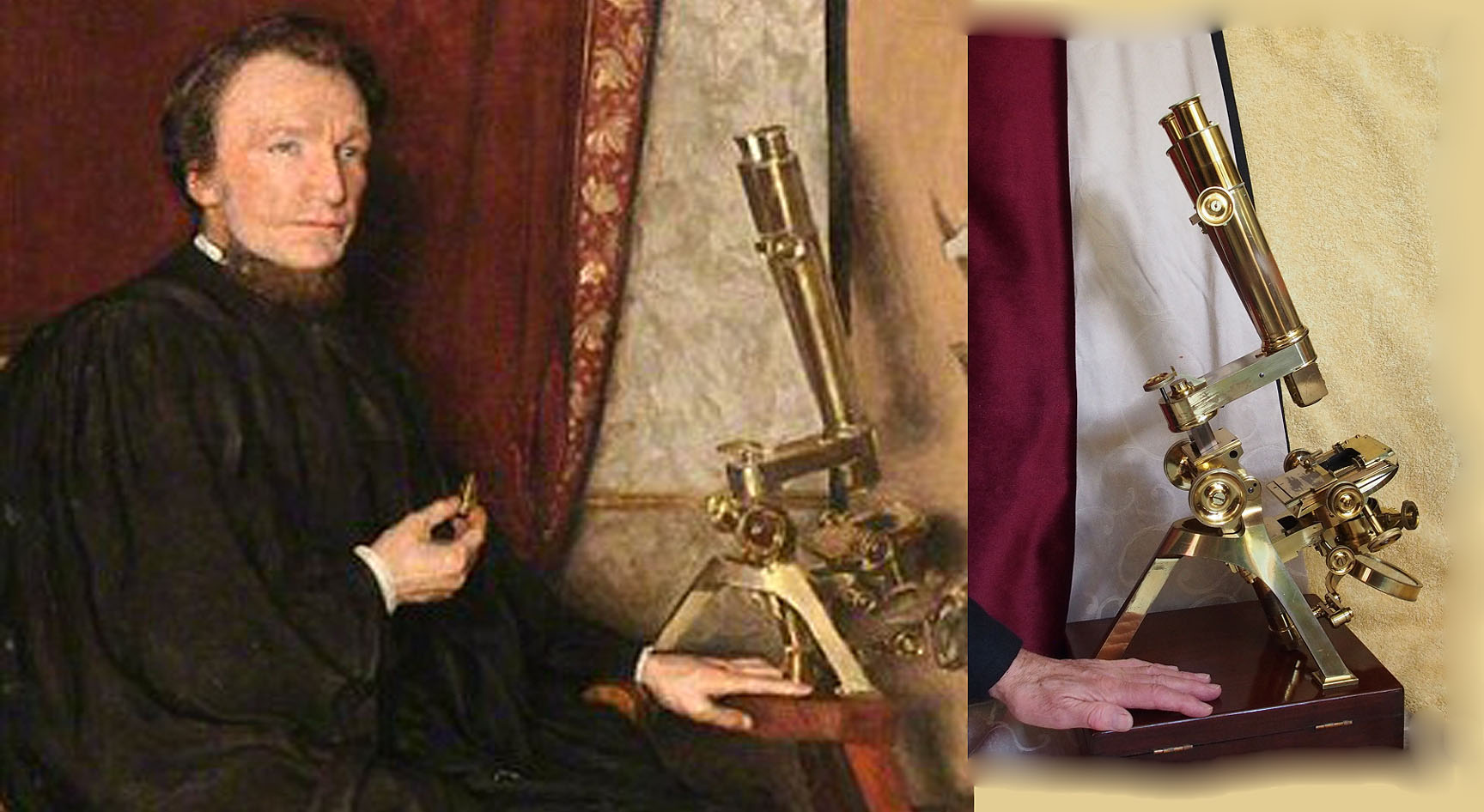
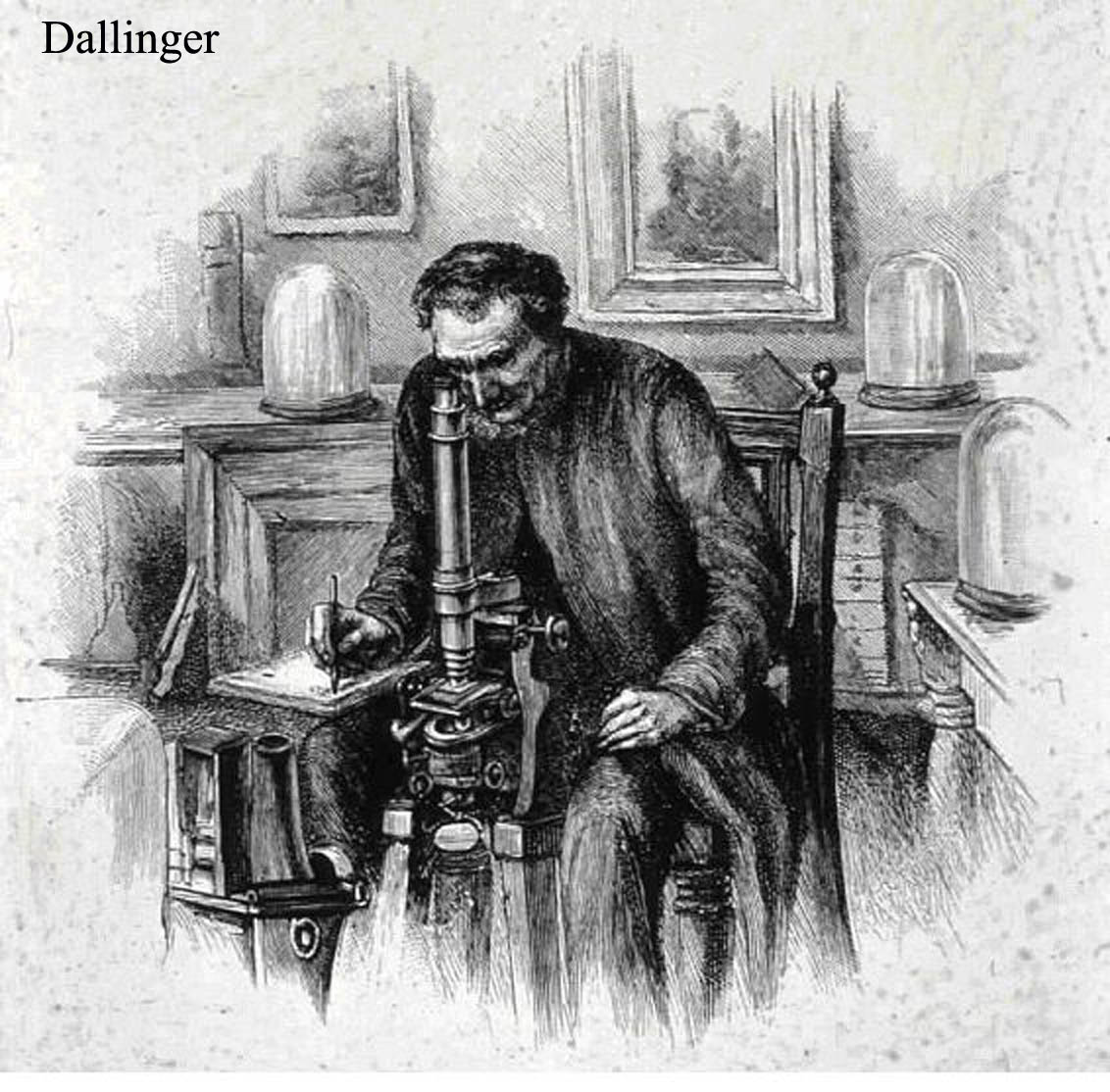 The Reverend Dr. William Henry Dallinger, F.R.S. (1839-1909), parson-naturalist and microscopist, was an enthusiastic user of the Powell & Lealand No 1 microscope, and the 1891 and 1901 editions of Carpenter s The Microscope and its Revelations, edited by him, include four engraved plates depicting the No 1 stand in use for different methods of observation. The painting of Dallinger in the Wellcome collection by Edgar Herbert Thomas, shown to the left, depicts him in academic gown seated at a binocular Powell & Lealand No 1 microscope. Note the similarity to the microscope pictured and discussed on this page. Dallinger also used a special stand, allowing the microscope to be used vertically for fluid mounts(right). He conducted research into saprophytic organisms, and with the extensive signs of use on the fine adjustment, and on one of the live boxes, it is tempting to speculate that he may have been the original owner of this very microscope, particularly considering the striking resemblance to the stand here discussed. Dallinger, being an author of books about the microscope, would be a good candidate to want to have all the various P & L objectives to write about in his book. Definitive proof to support this hypothesis is lacking, however.
The Reverend Dr. William Henry Dallinger, F.R.S. (1839-1909), parson-naturalist and microscopist, was an enthusiastic user of the Powell & Lealand No 1 microscope, and the 1891 and 1901 editions of Carpenter s The Microscope and its Revelations, edited by him, include four engraved plates depicting the No 1 stand in use for different methods of observation. The painting of Dallinger in the Wellcome collection by Edgar Herbert Thomas, shown to the left, depicts him in academic gown seated at a binocular Powell & Lealand No 1 microscope. Note the similarity to the microscope pictured and discussed on this page. Dallinger also used a special stand, allowing the microscope to be used vertically for fluid mounts(right). He conducted research into saprophytic organisms, and with the extensive signs of use on the fine adjustment, and on one of the live boxes, it is tempting to speculate that he may have been the original owner of this very microscope, particularly considering the striking resemblance to the stand here discussed. Dallinger, being an author of books about the microscope, would be a good candidate to want to have all the various P & L objectives to write about in his book. Definitive proof to support this hypothesis is lacking, however.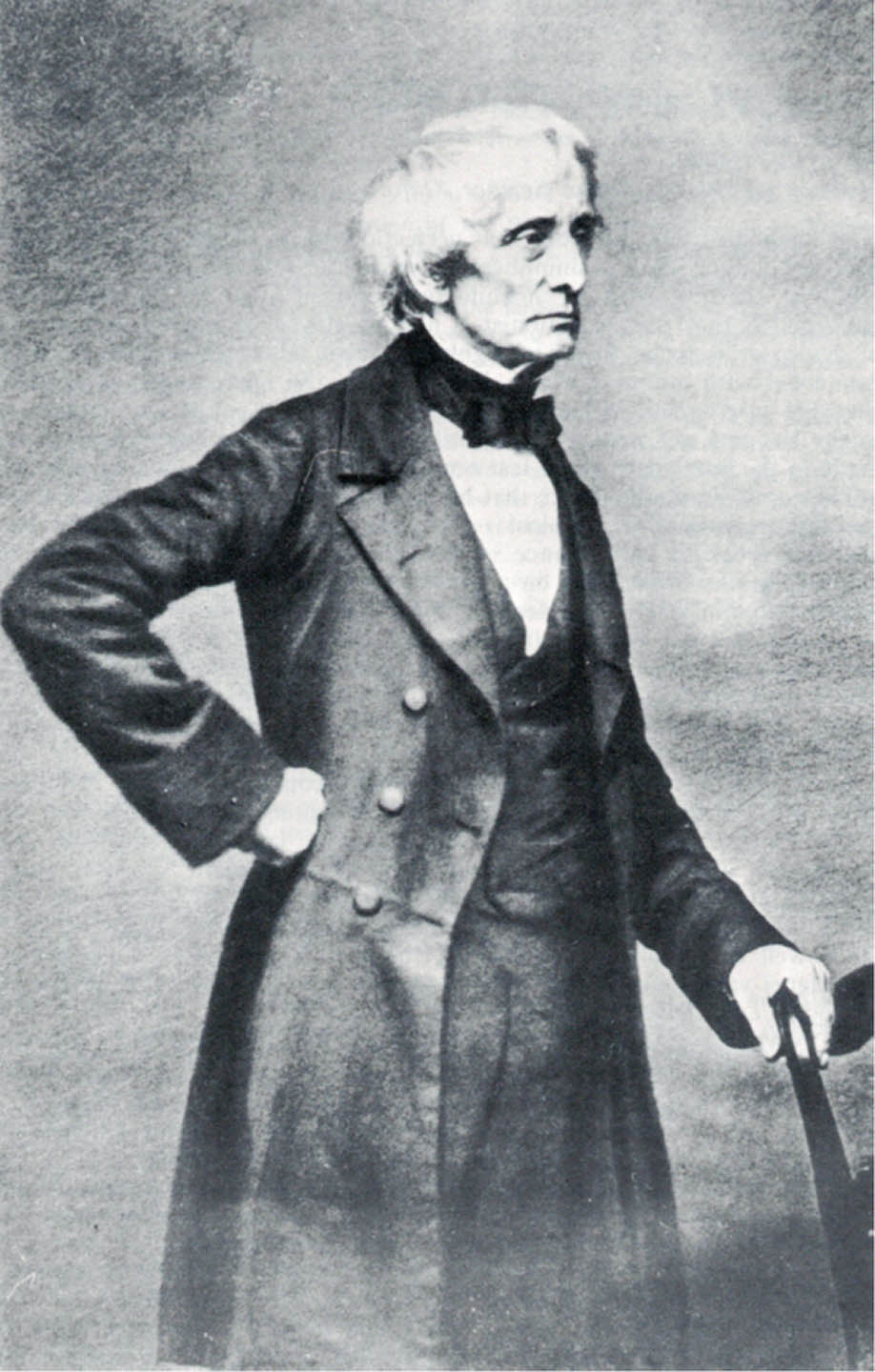 Hugh Powell(left) was born in 1799, and in his early working life he was a philosophical instrument maker to the trade, which in those days meant that one s work was often signed and sold by other retailers. The first mention of him is in 1831, regarding the first of three simple dissection microscopes made by him for Cornelius Varley (1781-1873). They both lived in the same neighborhood of London, Somers town. Varley was an inventor himself, and patented his graphic telescope in 1811. He was also a microscopist, and a painter, his favourite medium being watercolours. He was also one of the 17 gentlemen who met at the house of Edwin Quekett in 1839, to form the Microscopical Society of London, later the Royal Microscopical Society. It is also known that Powell was making mechanical microscope stages designed by the engraver, Edmund Turrell, who also produced some of Varley s illustrations for The Transactions of The Society of Arts, so there were many interconnections between men involved in microscopy.
Hugh Powell(left) was born in 1799, and in his early working life he was a philosophical instrument maker to the trade, which in those days meant that one s work was often signed and sold by other retailers. The first mention of him is in 1831, regarding the first of three simple dissection microscopes made by him for Cornelius Varley (1781-1873). They both lived in the same neighborhood of London, Somers town. Varley was an inventor himself, and patented his graphic telescope in 1811. He was also a microscopist, and a painter, his favourite medium being watercolours. He was also one of the 17 gentlemen who met at the house of Edwin Quekett in 1839, to form the Microscopical Society of London, later the Royal Microscopical Society. It is also known that Powell was making mechanical microscope stages designed by the engraver, Edmund Turrell, who also produced some of Varley s illustrations for The Transactions of The Society of Arts, so there were many interconnections between men involved in microscopy.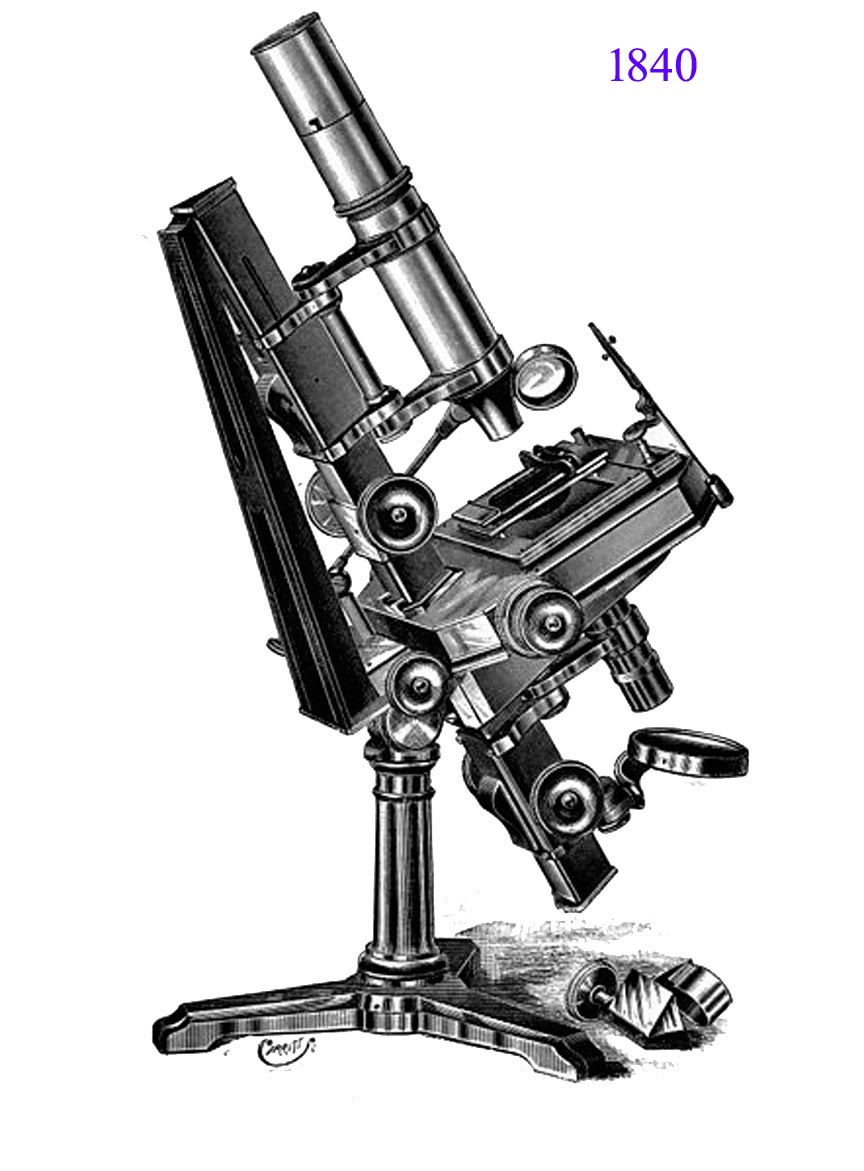
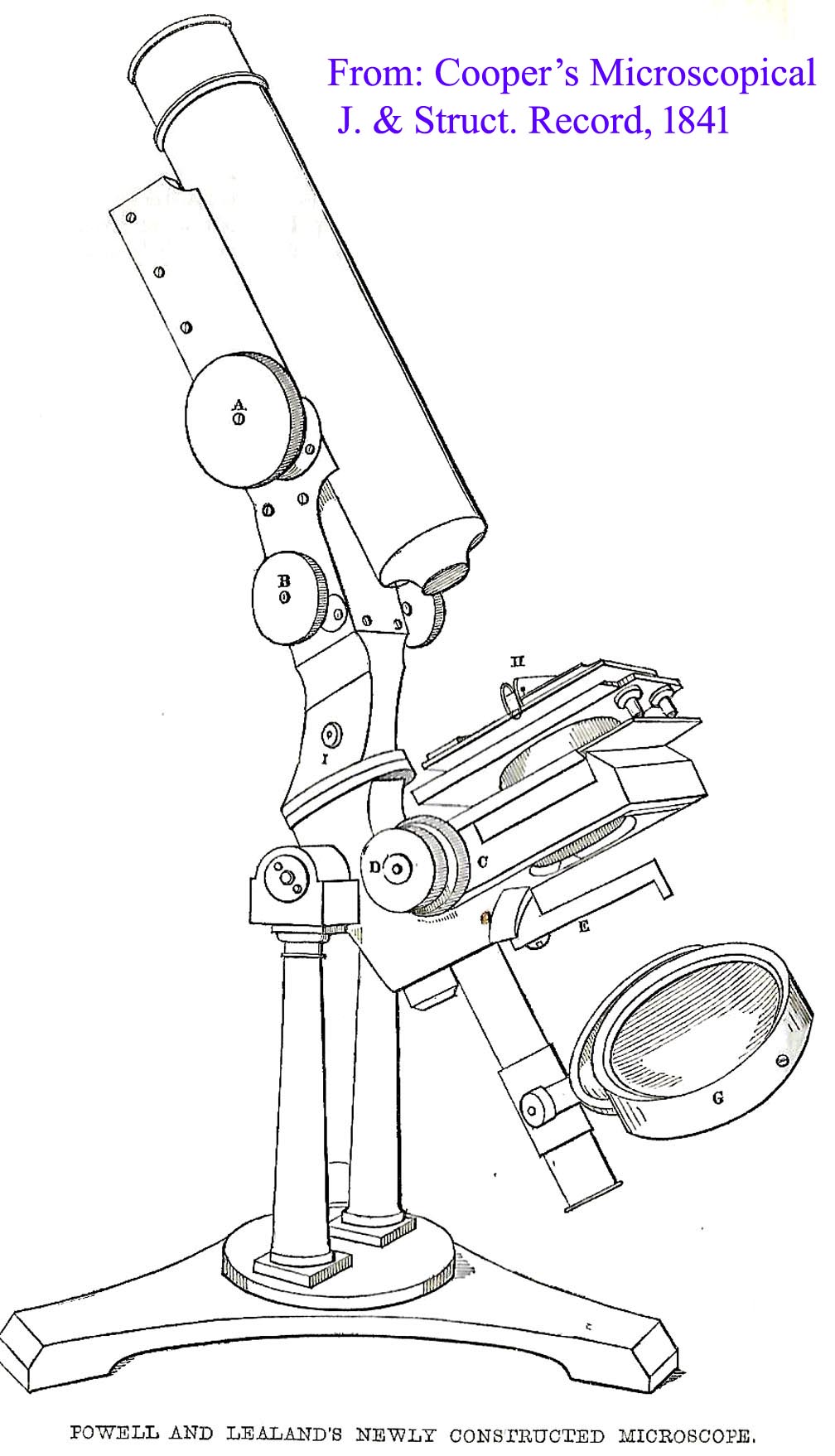 In 1840, the newly formed Microscopical Society commissioned
In 1840, the newly formed Microscopical Society commissioned Messrs Hugh Powell, Andrew Ross, and James Smith each to furnish a standard instrument made to their own peculiar views. Powell s massive model(left) as delivered to the Society is still part of the R.M.S. collection today, and features a solid triangular post, as well as the first example of an English microscope equipped of an achromatic condenser. A small number of this large model continued to be made until 1849.
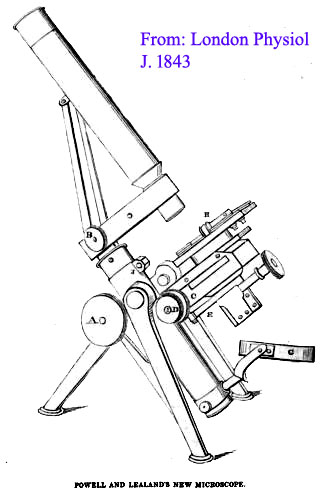 In 1843 Powell & Lealand came out with a radically new design on the bar-limb principle, combined with a tripod foot. An example of this 'New Microscope' from the first year of its production is now on this site. This coincides with the appearance of Andrew Ross s first bar-limb design microscope, but the tripod foot, which resembled a kettle-drum, was a distinct Powell & Lealand feature. This was described in that year s November issue of The London Physiological Journal as Powell & Lealand s new microscope . In this, the microscope is supported by tripod legs, and small rounded feet, which carry the body on trunnions, and there is a transverse arm which contains the long lever, which moves the nose-piece fine motion. In the initial design, the fine-focus screw, which was attached to a cone, was placed on the right side. In 1847 this was moved to the familiar vertical position on the top of the arm, immediately behind its pivot.
In 1843 Powell & Lealand came out with a radically new design on the bar-limb principle, combined with a tripod foot. An example of this 'New Microscope' from the first year of its production is now on this site. This coincides with the appearance of Andrew Ross s first bar-limb design microscope, but the tripod foot, which resembled a kettle-drum, was a distinct Powell & Lealand feature. This was described in that year s November issue of The London Physiological Journal as Powell & Lealand s new microscope . In this, the microscope is supported by tripod legs, and small rounded feet, which carry the body on trunnions, and there is a transverse arm which contains the long lever, which moves the nose-piece fine motion. In the initial design, the fine-focus screw, which was attached to a cone, was placed on the right side. In 1847 this was moved to the familiar vertical position on the top of the arm, immediately behind its pivot.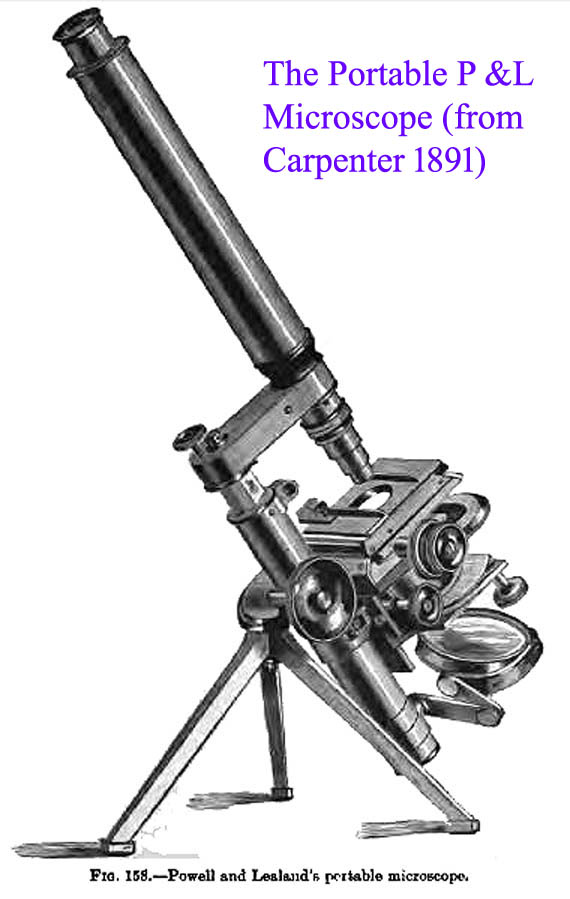 Coinciding with this development, a portable version of this model appeared, with folding feet, allowing the instrument to be packed neatly in a compact box. This was later known as the 'portable' or No 4 model(right), and the original design became known as the No 3 model. At this stage, the microscope tube was also supported by a set of diagonal stabilizing struts extending from the back of the arm to the upper third of the tube. Sometime during the early-1860s these were abandoned.
Coinciding with this development, a portable version of this model appeared, with folding feet, allowing the instrument to be packed neatly in a compact box. This was later known as the 'portable' or No 4 model(right), and the original design became known as the No 3 model. At this stage, the microscope tube was also supported by a set of diagonal stabilizing struts extending from the back of the arm to the upper third of the tube. Sometime during the early-1860s these were abandoned.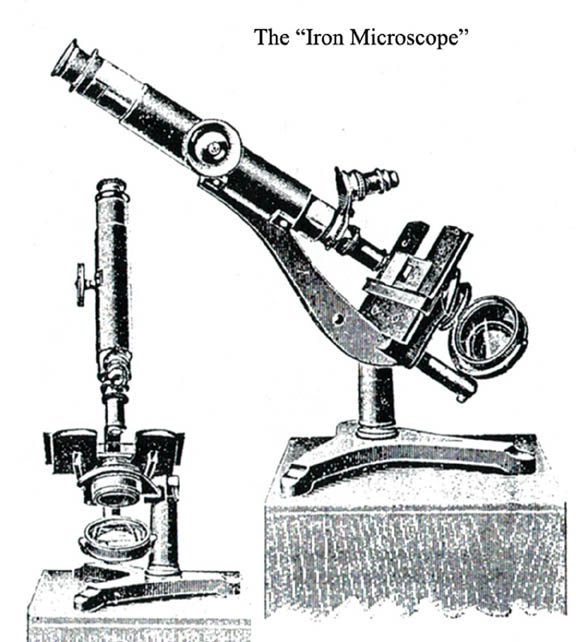 In 1848, a student model was developed, later referred to as 'The Iron Microscope' (left). This had an off-set pillar and flat tripod stand, a single coarse-adjustment milled head placed on the right, and a lever-operated stage as designed by Alfred White. Some examples of this instrument had a foot wholly made in brass, and some were signed by other retailers, such as Carpenter & Westley. This model continued to be made until the first decade of the 20th Century, and was later known as their No 5 or Student Model.
In 1848, a student model was developed, later referred to as 'The Iron Microscope' (left). This had an off-set pillar and flat tripod stand, a single coarse-adjustment milled head placed on the right, and a lever-operated stage as designed by Alfred White. Some examples of this instrument had a foot wholly made in brass, and some were signed by other retailers, such as Carpenter & Westley. This model continued to be made until the first decade of the 20th Century, and was later known as their No 5 or Student Model. Powell & Lealand did not enter the 1851 Great Exhibition, but it is believed that during this time they worked on a larger model based on their 1843 tripod design. Dated examples are extant from this period, including two on this site, which have the more solid rectangular legs and feet as in the later No 1 and 2 designs, either with or without the supporting struts. These could be regarded as the proto-No 1/No 2 stands , from which the later models were developed.
Powell & Lealand did not enter the 1851 Great Exhibition, but it is believed that during this time they worked on a larger model based on their 1843 tripod design. Dated examples are extant from this period, including two on this site, which have the more solid rectangular legs and feet as in the later No 1 and 2 designs, either with or without the supporting struts. These could be regarded as the proto-No 1/No 2 stands , from which the later models were developed. The next model(right) was worked on at odd times and appeared in 1861. It was similar in outline and appearance as the final No 1 design, save for the massive ring attached to the limb, within which there was a second ring carrying the stage and substage assembly, allowing both to be rotated with the same rack-and-pinion movement, and separate rotation also provided for the substage. This model continued to be made until the definitive version of the No 1 model stand was put on the market in 1869.
The next model(right) was worked on at odd times and appeared in 1861. It was similar in outline and appearance as the final No 1 design, save for the massive ring attached to the limb, within which there was a second ring carrying the stage and substage assembly, allowing both to be rotated with the same rack-and-pinion movement, and separate rotation also provided for the substage. This model continued to be made until the definitive version of the No 1 model stand was put on the market in 1869.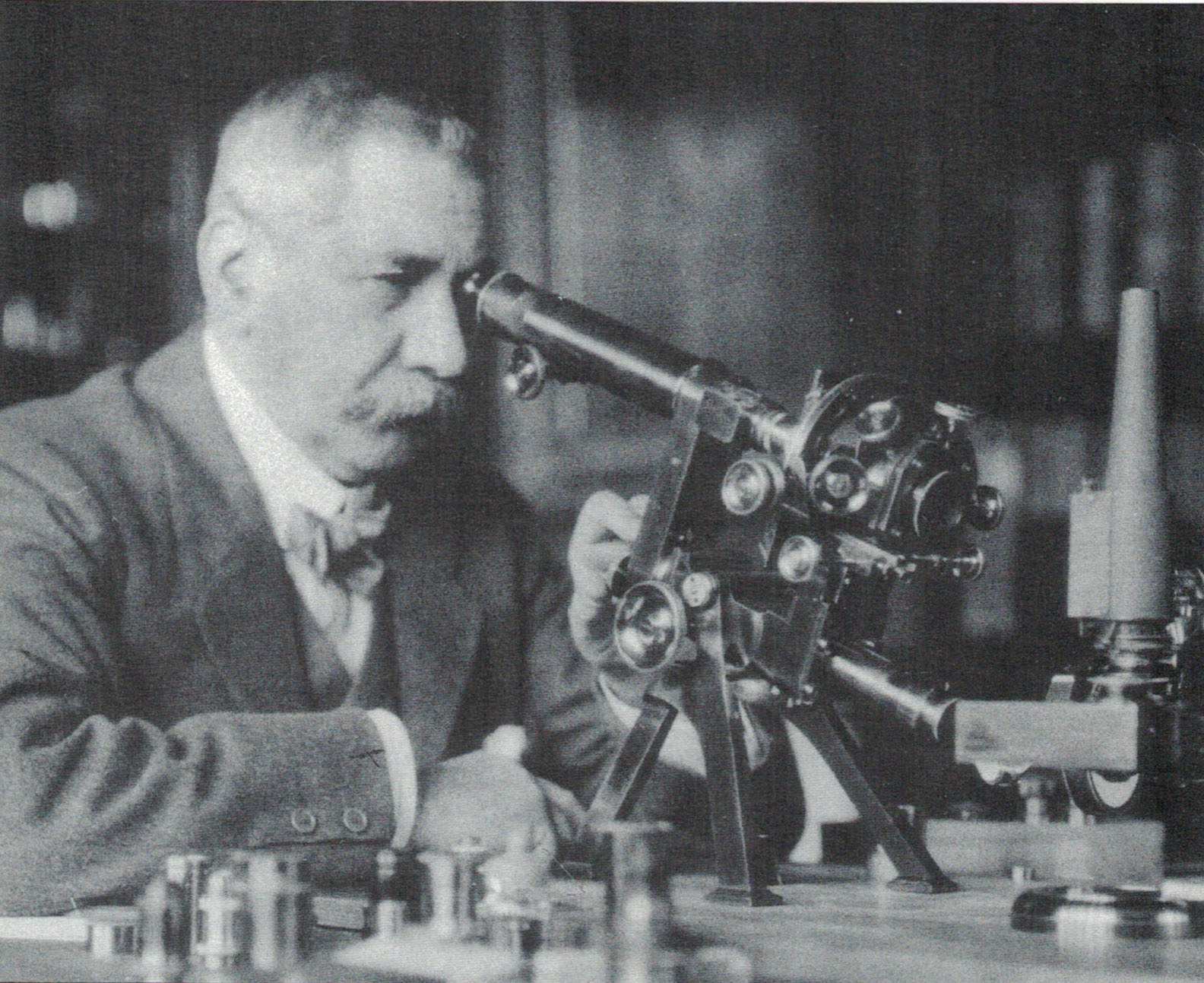
 Alongside the No 1 model stand, Powell & Lealand developed another, slightly smaller model, known as their No 2 (left). This differed from their No 1 in four respects: Instead of 1 inch, it had inch X and Y motion to the stage; instead of a rotating stage, it had a sliding and rotating object holder; the stage plates were not graduated; and when inclined horizontally, the eye point was a distance of less than 10 inches from the table surface. It did feature the same centering and rotating substage as on the No 1.
Alongside the No 1 model stand, Powell & Lealand developed another, slightly smaller model, known as their No 2 (left). This differed from their No 1 in four respects: Instead of 1 inch, it had inch X and Y motion to the stage; instead of a rotating stage, it had a sliding and rotating object holder; the stage plates were not graduated; and when inclined horizontally, the eye point was a distance of less than 10 inches from the table surface. It did feature the same centering and rotating substage as on the No 1. 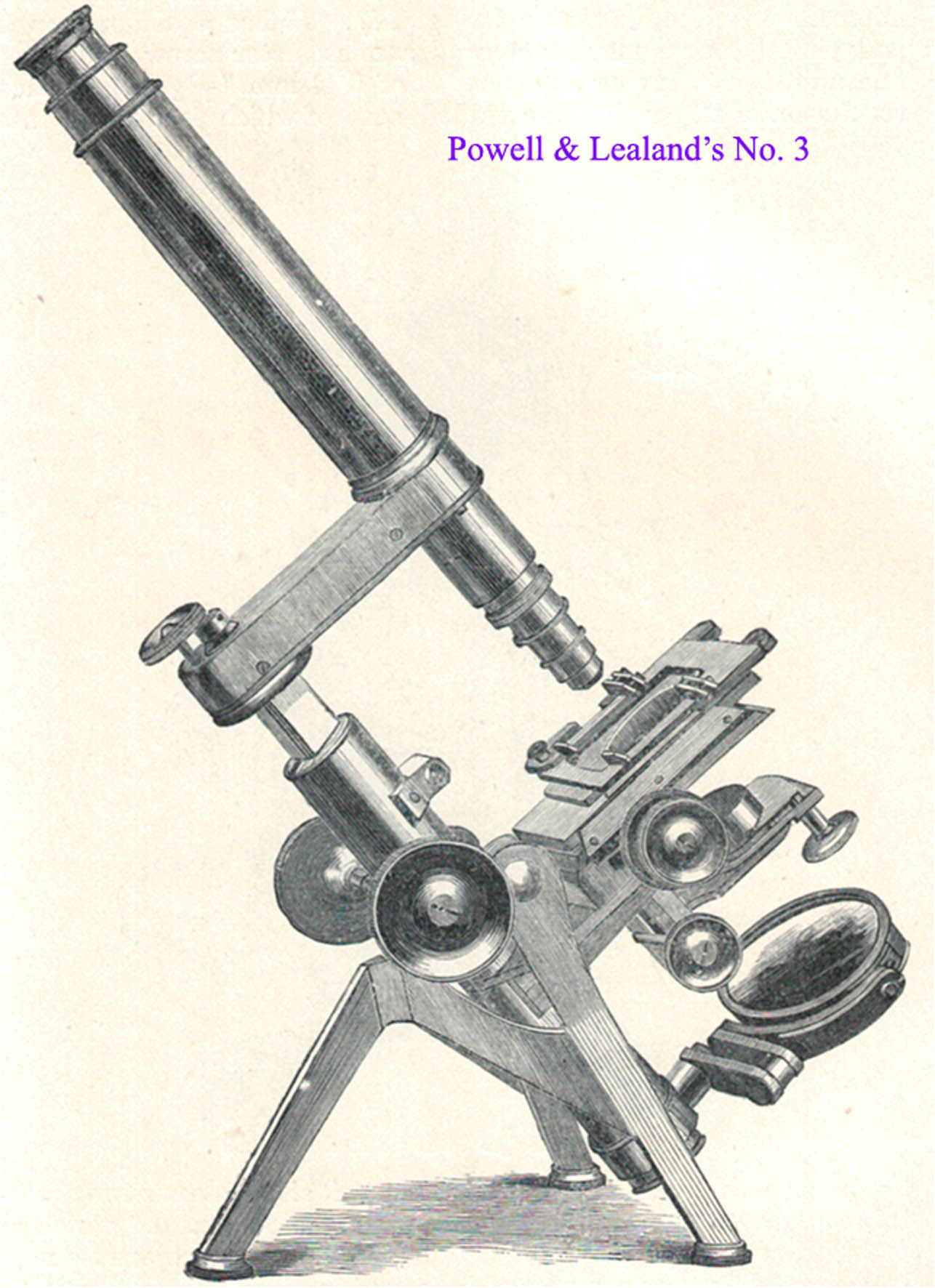 In addition, Powell & Lealand continued to produce their original design with the ranker tripod foot, now designated their No 3 stand(right). This differed from the No 2 in that it was smaller again, had no rotary movement to the substage, and instead of rectangular mechanical movements to the substage it had mechanical eccentric centering movements.
In addition, Powell & Lealand continued to produce their original design with the ranker tripod foot, now designated their No 3 stand(right). This differed from the No 2 in that it was smaller again, had no rotary movement to the substage, and instead of rectangular mechanical movements to the substage it had mechanical eccentric centering movements.